Which Data Type We Use For Mobile Number In Blyerpsim
Blue Prism - Quick Guide
Blue Prism - Introduction to RPA
A robot is a machine that mimics the human user in performing various tasks, such as clicks, navigations, typing, etc. Sequence of meaningful activities that may involve multiple systems or applications brand upwards a process. Automation is the sequence of steps which are performed without any man interference (once configured).
Robotic Process Automation
Robotic process automation (RPA) allows using software robots instead of people to bulldoze the business. It is used to automate regular tasks and then the user can concentrate on accomplishing complex tasks rather than routine piece of work manually. This would in plow reduce the human errors.
RPA Benefits
The following are the advantages of RPA −
-
Building a unified view of the customer
-
Increased customer satisfaction
-
Increased employee productivity
-
More accurateness and quality
-
Cost effective
-
Upwards to 80% reduction in AHT (Average Handle Time)
-
Upward to 90% reduction in Art (Average Resolution Fourth dimension)
-
Increased ROI (Return on Investment) within three months on an average.
RPA Tools
We have the following popular tools available in marketplace for RPA −
-
Blue Prism
-
Automation Anywhere
-
Ui Path
-
Work Fusion
-
Open Span
Uses of RPA
The following are the uses of RPA −
Dual data entry scenarios
Information manually entered in ane system need non exist reentered into another system. RPA replaces such dual man effort since invoices are indexed in the workflow and and so manually reentered in ERP.
Straight-through processing
Inputs arriving from various systems such as web pages for client orders, workflow for invoices, emails or excel files must exist entered into ERP. Withal, if the input is clean and the rules are well laid out that data entry can be done through RPA.
Virtual integration between different systems
Standalone, Legacy, ERP or workflow systems often practise not communicate with i another and integrating them would cost millions of dollars and precious IT fourth dimension, RPA can provide light weight integration connecting disparate systems at the user interface level.
Responding to information extraction and responding requests
When information and report requests come from multiple procedure owners, vendors, and even terminate customers, employees log into a arrangement to extract the data, format it, and ship an electronic mail to the requestor. RPA lends itself well to such rule-based tasks.
Rule based determination making
RPA can execute decision-based tasks provided the rules driving those decisions are well laid out. For instance, on an invoice coming from a utility vendor, RPA can change payment terms to "immediate" from whatever is on the invoice.
Life Cycle of RPA
The lifecycle of RPA is given below −

Clarify and Identify
Step 1 of RPA life cycle is to analyze a business trouble for RPA development. This is usually done by business analysts and RPA architects. Processes which can be automated are identified, timelines for the development are decided, approach is documented, and approving is obtained from stakeholders to get-go the development.
Implement
RPA developers piece of work on the requirements in development surround to automate the manual processes. Evolution is washed in wizard and these is a express requirement to perform coding in developing the bots.
Testing
In this phase, bots are tested to evaluate the quality and to right errors if whatsoever.
Get Live
After the bot is tested thoroughly, it would exist deployed into the live surroundings where users outset using information technology. It enters maintenance phase where support and change requests for the bot are entertained and defects are fixed with immediate issue.
Types of Robot in RPA
In that location are two types of robots in RPA equally given below −
- Back Office Robots
- Front Office Robots
Back Office Robots
Following are the features of dorsum office robots −
-
Dorsum office robots volition run unattended.
-
They are in batch Mode.
-
They run in virtual environments.
-
Back office robots are not supervised by whatsoever one.
-
The back office robots send heartbeats to the server, so that it knows instantly when a robot is down.
-
Dorsum office robots help in error reduction and are toll effective.
Front Office Robots
Following are the features of front part robots −
-
Front function robots share the same workstation as an employee who has control over where and when it is used.
-
Front office robots are stand solitary and they demand human interference.
-
User triggers these robots and they run only nether manual surveillance.
-
Front role robots operate from local automobile and cannot exist run or scheduled remotely.
Blue Prism - Introduction
Blue prism is a Uk-Based Software Company and is one of the leading robotic process automation tools. It is used to automate mundane tasks such that they could operate without any manual intervention. Bluish prism has gained edge over its competitors as information technology has ameliorate security, flexibility, scalability, compliance, and resilience.
Pre-requirements for Blue Prism
The following are the pre-requisites for the Blue Prism. It is the only software which −
-
Creates and supports a digital workforce of industrial forcefulness and enterprise scale
-
Does not require IT skills to implement
-
Can be implemented in sprints of 4 to 8 weeks (Start to finish)
-
Is very low cost compared to the TCO of alternative solutions
-
Provides tremendous payback with self-funding returns and an ROI that has been as loftier as fourscore%
-
Tin can exist managed within IT infrastructure and processes
Installation of Blue Prism
The following are the installation requirements for Blue Prism −
-
Windows seven (Preferred) Bone, 64 flake or 32 chip
-
Blue prism installation Software, 64 or 32 scrap, depending on your Os
-
Bluish Prism License File
-
SQL Server Express Edition, 64 or 32 bit depending on your OS
We shall look at the process of installing Blue Prism with SQL Server Direction Studio −
Installation of SqlExpr
Download SQL server, SqlExpr.exe file from Microsoft official website and after the download click on SqlExpr. This volition launch the Sql Server that tin can be used to install the Sql connection.
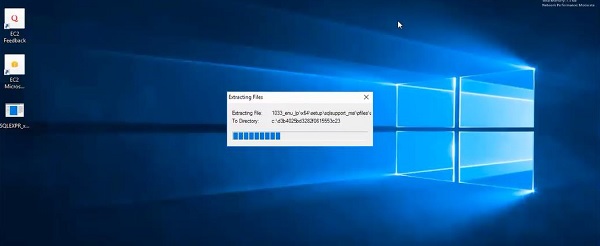
Installing Blue Prism
One time the SQL server is installed, nosotros need to install Bluish Prism using the steps given beneath and the screenshots −
Footstep one − Click on Blue Prism v.0.10_x64 for the installation to start.
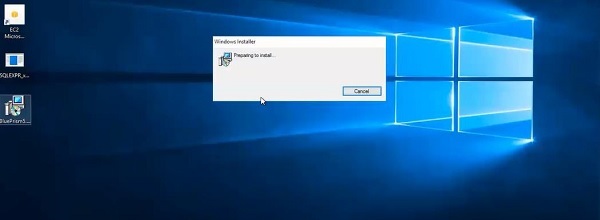
Stride ii − Click on next on the dialogue box.
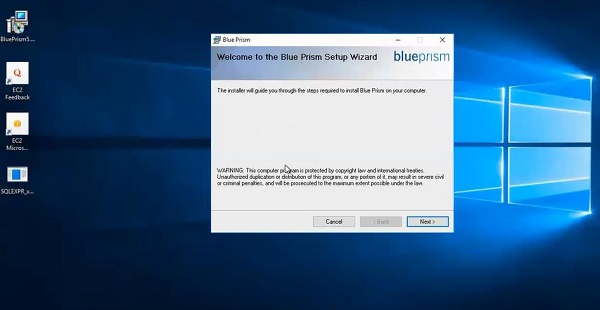
Step 3 − Agree to the License Agreement.
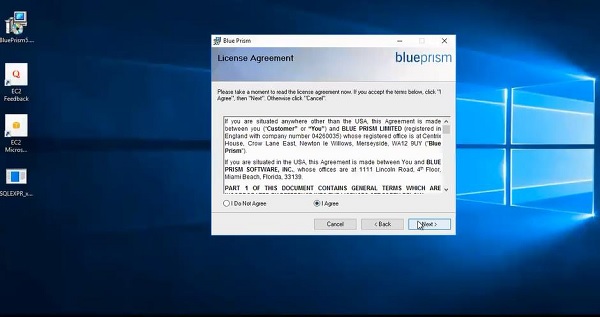
Stride 4 − Cull the installation folder.
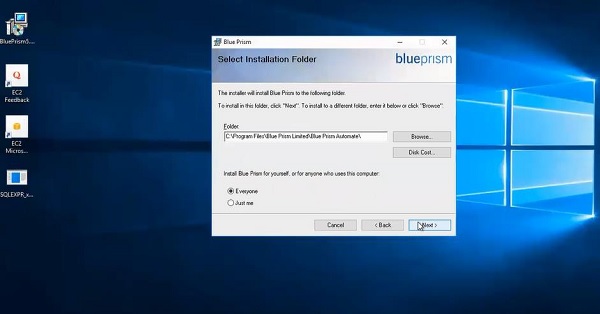
Step 5 − Click on next.
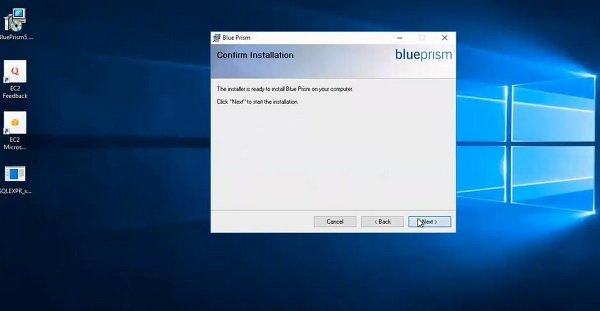
Stride vi − Once you click on next, the installation processes.
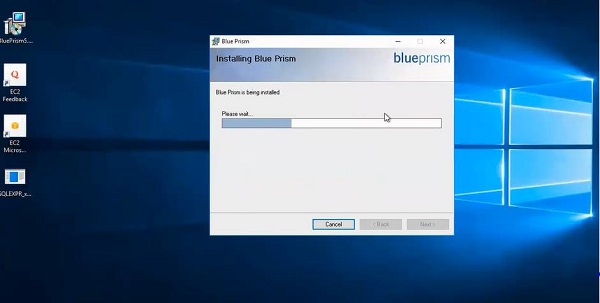
Step 7 − Once the installation is completed, close the window.
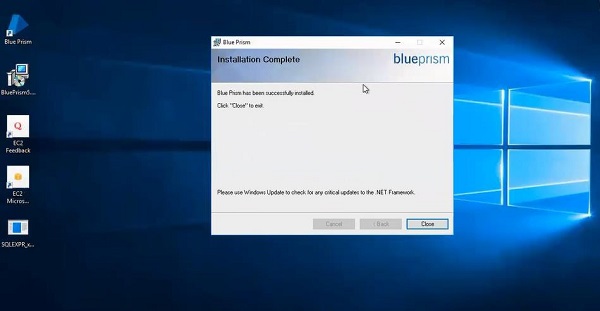
This completes the installation of Blue Prism and the icon appears on the desktop.
Opening Blue Prism
Once the installation of Blue Prism is completed, we shall expect at how to open the awarding using the beneath steps −
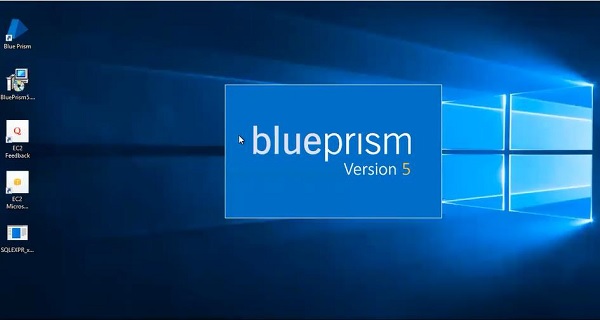
Click on Icon
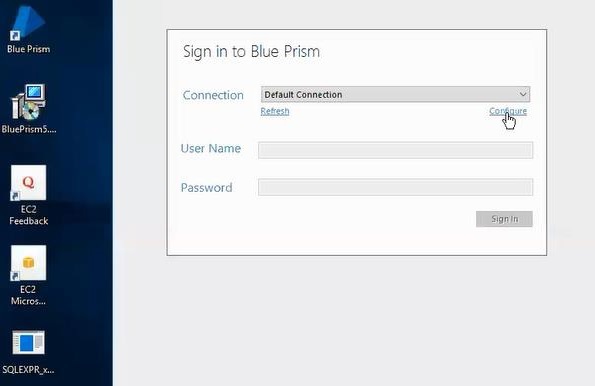
The default Username and Password for Blue Prism are as follows −
-
Username: Admin
-
Password: Admin
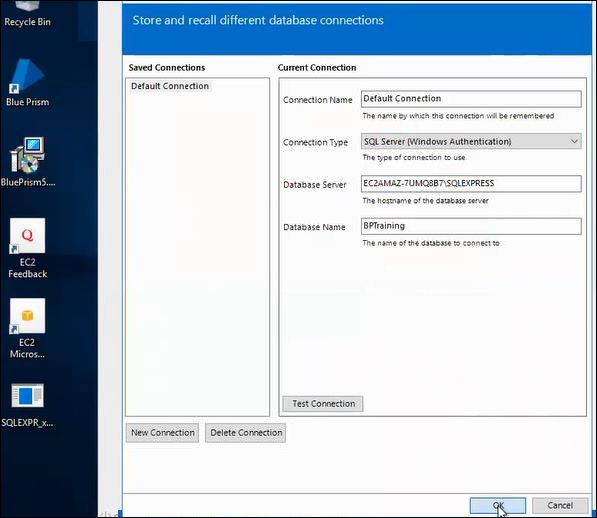
Creating the Database
We shall now create a database using Blue Prism every bit shown in the beneath images −
First, open the installed application and go to File and then click on Create Database.
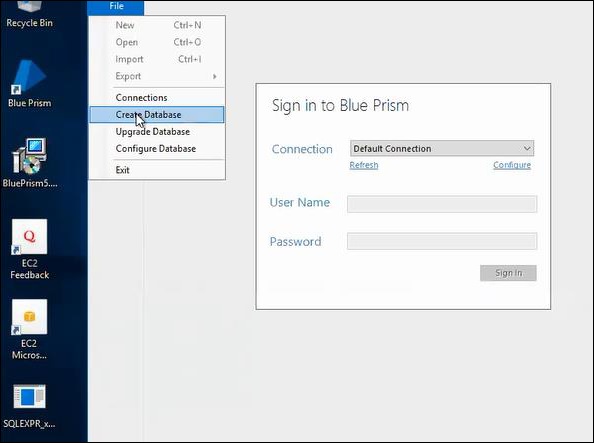
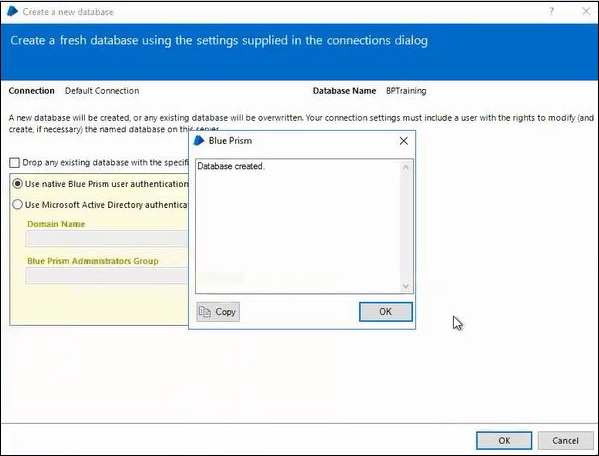
Now that the database is created, sign with the default username and countersign.
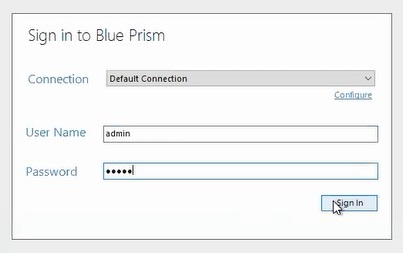
Subsequently clicking on sign in button, choose a new password for user.
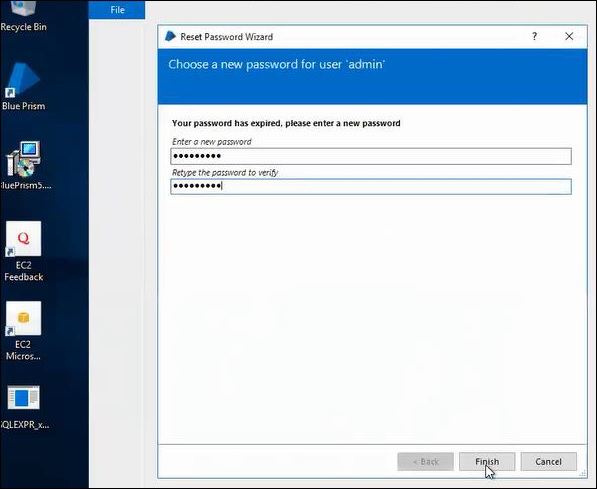
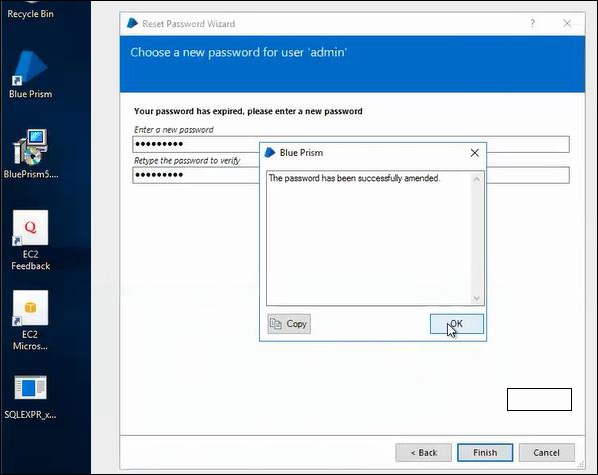
Different tabs of Blueish Prism
There are 6 types of tabs in Blue Prism as follows −
- Domicile
- Studio
- Control
- Dashboard
- Releases
- System
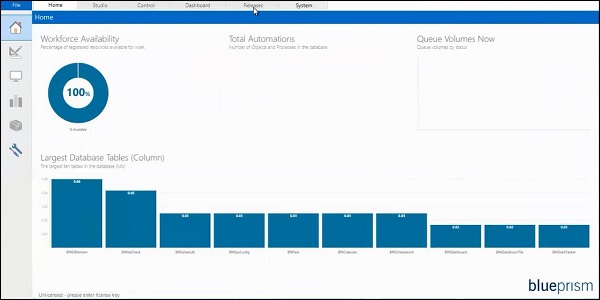
The post-obit is the overview of different parts of Blue Prism −
Home
Home has displays different charts which gives information most the blue prism database. Workforce availability shows the run time resource that we are using, total automations shows the number of queues and automations in the database, queue volumes now gives the queue volumes by condition and largest database tables shows the largest tables in the blue prism database.
Studio
Studio is an important part of Blue Prism where we implement actual automation steps. There are 2 studios: Object Studio and Process Studio.
Control
Control room is the key point of administration in Blue Prism where it handles control, monitor, execute and schedule of process executions on the distributed bots.
Dashboard
Dashboard is used to describe different charts displaying information about robotic work strength.
Releases
Release manager is used to manage import and consign of configuration packages betwixt different blue prism environments.
System
System tab is used by administrator for user management.
Blue Prism - Object Studio
Object studio is mainly used to develop the objects. Within the object, nosotros have unlike types of deportment as follows −
-
the Application Modular to Spy the Elements
-
initialize page and clean up page
Creating the Object from Object Studio
Afterwards launching the Blue Prism, open Studio tab, right click on Objects and select Create Object. The screenshots clearly explain the process of creating objects −
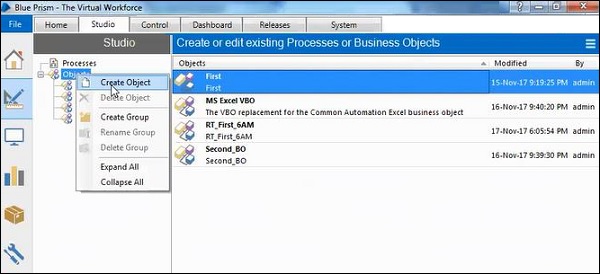
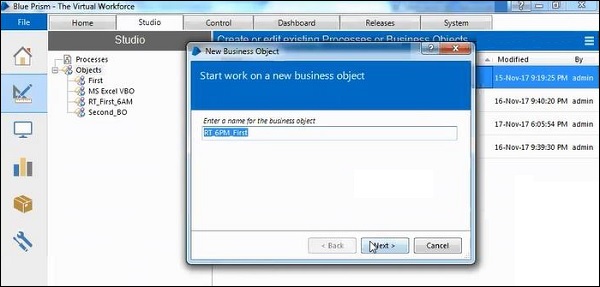
Provide a name for new business object.
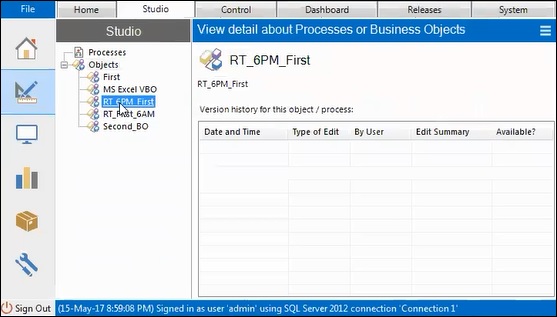
It will create an object in objects listing.
Dissimilar Stages in Object Studio
The different stages in the Object Studio are listed below −
- Link
- Block
- Read
- Write
- Navigate
- Code
- Wait
- Process
- Page
- Action
- Conclusion
- Option
- Calculation
- Multi Adding
- Data Item
- Collection
- Loop
- Note
- Anchor
- End
- Exception
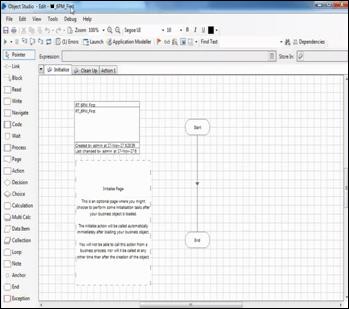
Once you create an object, the initialize, cleanup and action pages will be created and the initialize page volition exist launched with the above mentioned stages.
The below Concern Object (VBO) will give y'all more detailed explanation of how the stages tin be used and how the VBO works.
Understanding Collections to Excel
Multiple values stored in the grade of rows and columns are called collections.
We phone call add together rows to collections using the below two means −
-
Using Internal VBO as "collections".
-
Using "Utility-Collection Manipulation" VBO.
Create a Business Object
Enter the proper noun of the business object yous similar to create as shown below −
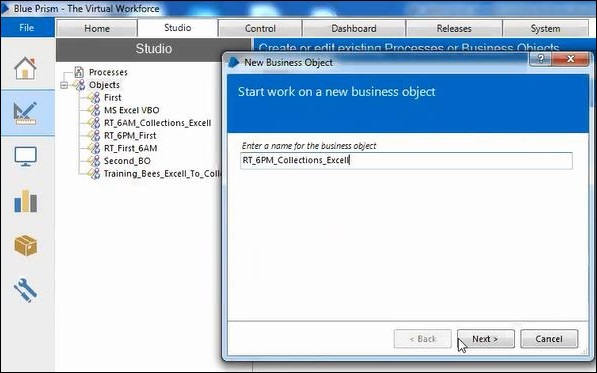
Now, enter the description of the business organization object as shown below −
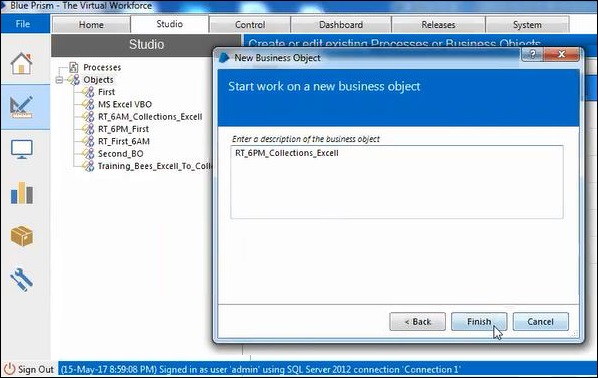
Then, click on Stop.
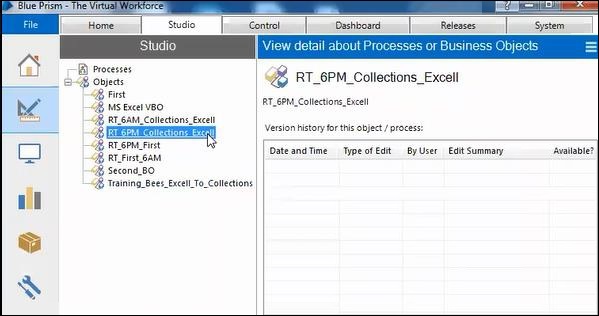
Double click on newly created VBO to open information technology.
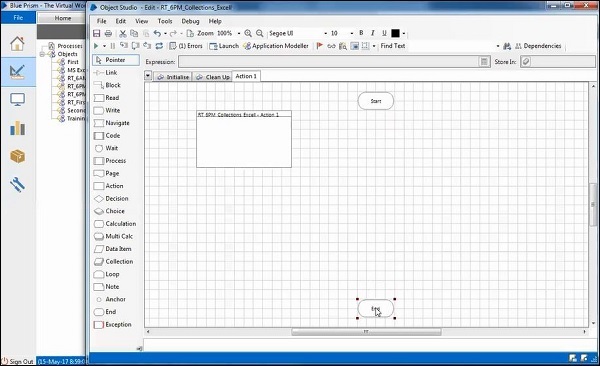
In the action tab, the start and terminate stages volition be created by default with a link to them, select the link and delete, then that the actual stages tin can exist implemented in information technology.
Create a collection and add rows to the drove using the internal VBO.
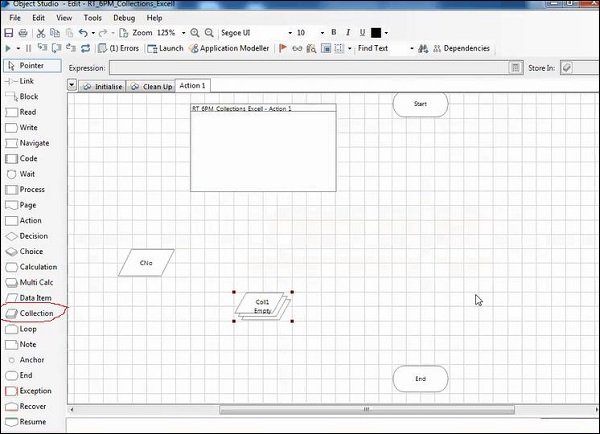
Provide the collection name, description and provide details in fields: proper noun, type, description and fields. Use Add field to add together whatsoever extra field.
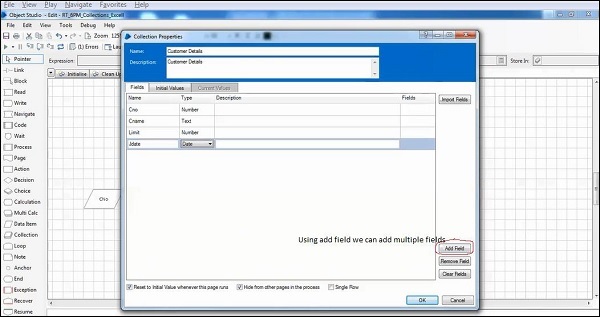
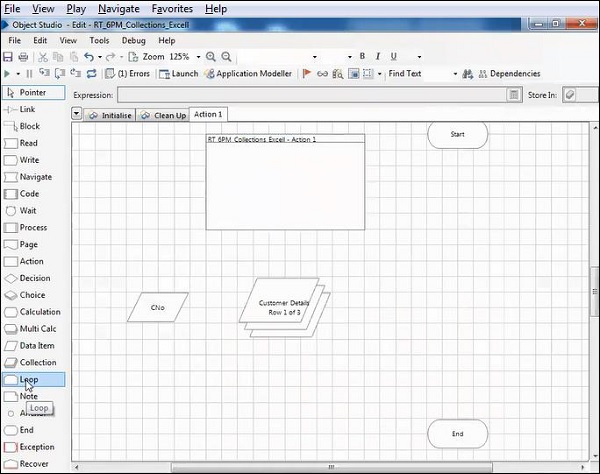
Apply Loop Stage
Select Loop from the stages, loop volition have start and end parts. It is used to execute the stages in the loop with the mentioned iterations.
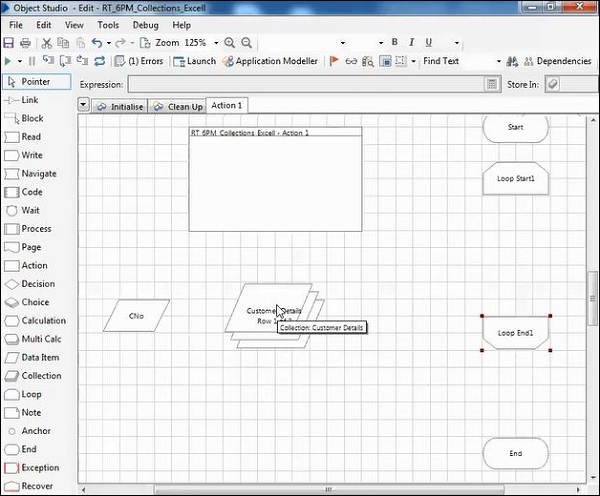
Provide the name for the loop and select the correct drove from the drop downward listing.
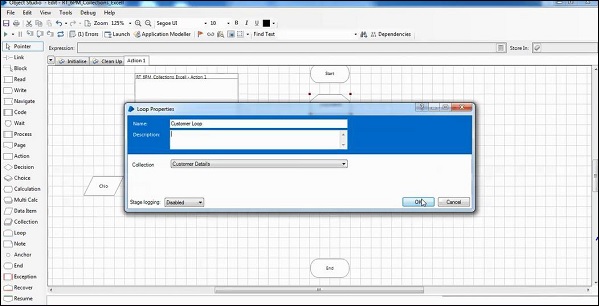
Create four date items
Using the data item stage, create four data items as given below −
- C no
- C name
- Limit
- Jdate
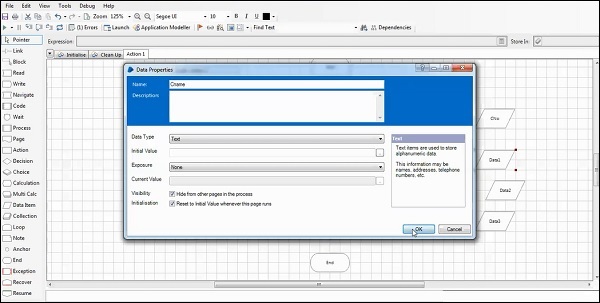
Use Multi Calculation to add data to collection in the empty row.
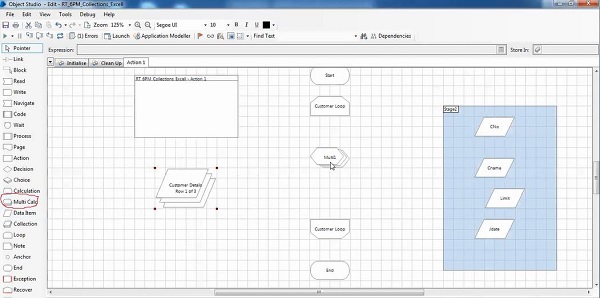
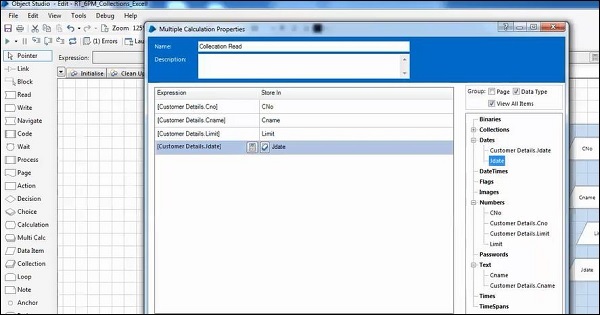
Provide a proper name to that multi adding, drag the expression from collection list to expression, and drag the information items from the data item listing to Shop In values.
-
Link the stages using Link and save the Business concern object.
-
Execute the VBO by clicking on play button.
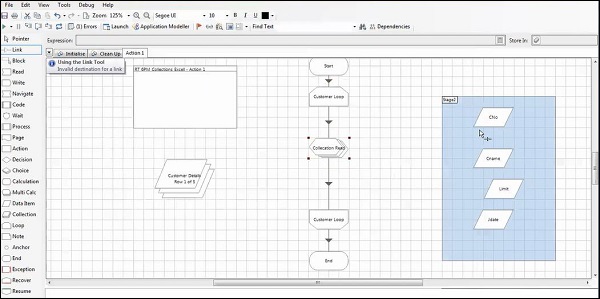
The event will be with the proper outputs which were provided in the collection as shown beneath −
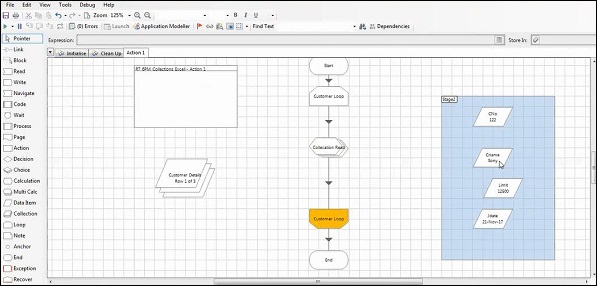
We will understand the collections with Excel every bit shown beneath −
First, we need to create an instance and accept the output as 'handle' and so open the work book proper name and pass the handle every bit input parameters.
It will write the work volume name, then perform another activeness become worksheet every bit collections.
Step 1: Create instance
Activity −
Proper name: Create case
Description: Create instance
Business Object −
Ms Excel VBO
Action: Create Instance
Output: Handle
Footstep 2: Open
Business Object: Ms Excel VBO
Activity: Open up workbook
Input −
Value= Handle
File Proper name
Output: store in workbook.
Step 3: Show
Business concern Object: Ms Excel VBO
Activity: Evidence
Input −
Value = Handle
Footstep four: Read data into collections
Business Object: Ms Excel VBO
Action: Get worksheet as collection (Fast)
Output: shop in Customer Details.
Step 5: Loop
Go to Loop backdrop
Proper name: Read the data from collection
Description: Read the data from collection
Collection: Customer Details.
Step vi: Multi Calculation
Name: Customer data
Customer details.
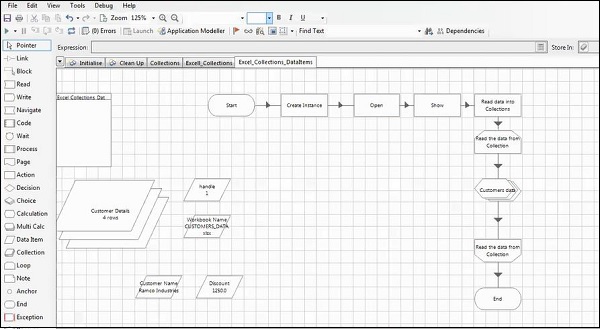
Understanding Choice with Collection and Excel
Nosotros demand to create student Data with the given information −
-
Course A >=ninety
-
Form B >=75
-
Grade C >=threescore
-
Grade D >=50
Stride 1: Create instance
Action −
Proper noun: Create example
Description: Create example
Business Object −
Ms Excel VBO
Activity: Create Instance
Output: Handle
Step 2: Open
Business Object: Ms Excel VBO
Activity: Open workbook
Input −
Value= Handle
File Name
Output: shop in workbook.
Footstep 3: Bear witness
Business Object: Ms Excel VBO
Action: Show
Input −
Value= Handle
Step 4: Read data into collections
Business concern Object: Ms Excel VBO
Action: Get worksheet equally collection (Fast)
Output: shop in Students Details.
Pace 5: Loop
Get to Loop properties
Name: Read the information from collection
Description: Read the data from collection
Drove: Student details
Step 6: Choice
| Pick Name | Choice Criterion |
|---|---|
| Grade A | Student Details Marks>=90 and <=100 |
| Grade B | Educatee Details Marks>=75 |
| Class C | Student Details Marks>=lx |
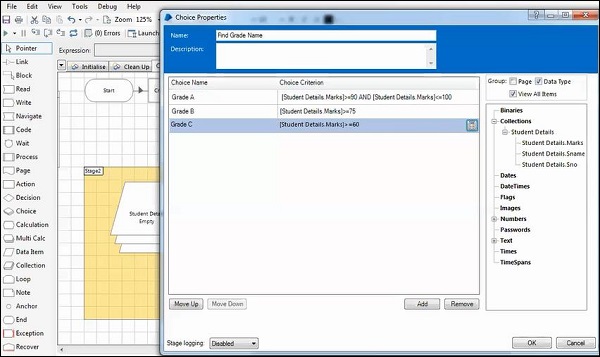
Create one information item as Course.
Create calculation as follows −
- Form A
- Grade B
- Grade C
Before the loop, nosotros demand to configure the values.
Take the Action stage:
Name: Default Prison cell
Business concern Object: Ms Excel VB
Activeness: Active workbook
Then,
Perform another action - Current Cell
Business Object: Ms Excel VBO
Activeness: go Active Cell
Output shop in Current cell.
So,
Write the information into excel
Business concern Object: Ms Excel VBO
Activeness: Set Cell Value
Perform some other activeness - Go to Next Prison cell
Business Object: Ms Excel VBO
Activeness: Go to Next Empty cell downwards
Input: store in current cell.
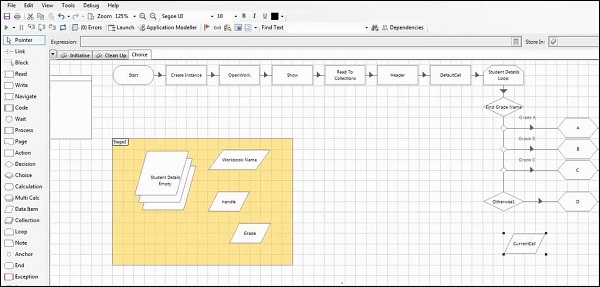
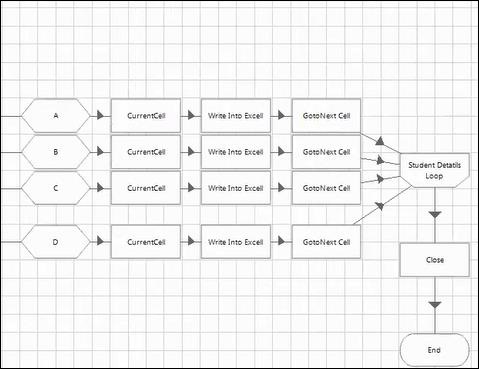
Blue Prism - Application Modeller
Application modeller is used for spying the applications. Spying is identifying the elements in the Applications.
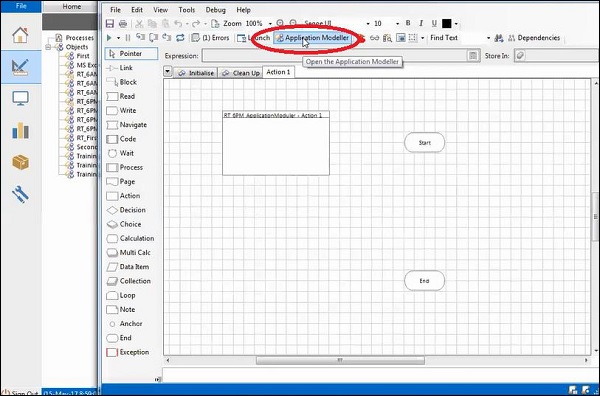
Application modeller window is as follows −
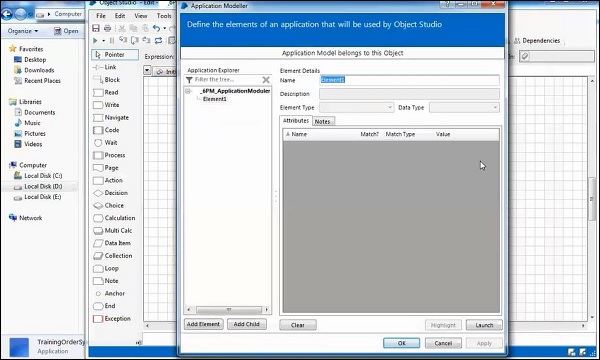
Spying Modes
We have 4 different types of spying modes as shown below −
-
Win32 Mode
-
HTML Mode
-
Accessibility Fashion
-
Region Mode
Follow the below steps to select any of the spying modes or to switch between different modes −
-
Utilize Ctrl and Left-Click to select the highlighted item in spying modes.
-
Use Ctrl and Correct-Click to Abolish.
-
Printing the Alt Key to switch spy modes.
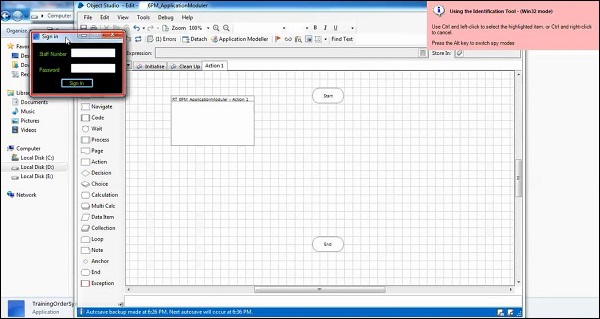
Working with Web Applications
Nosotros shall now discuss how to work with web applications −
Facebook login and logout
Starting time, let us create a business object and enter a proper name for it.
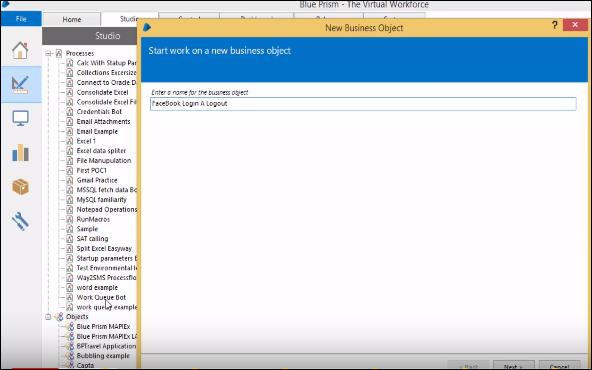
We need to configure the Awarding Modeller.
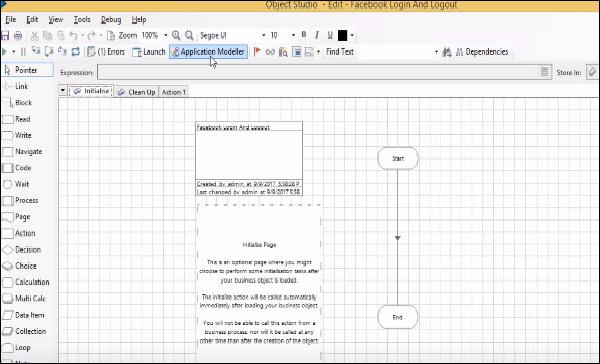
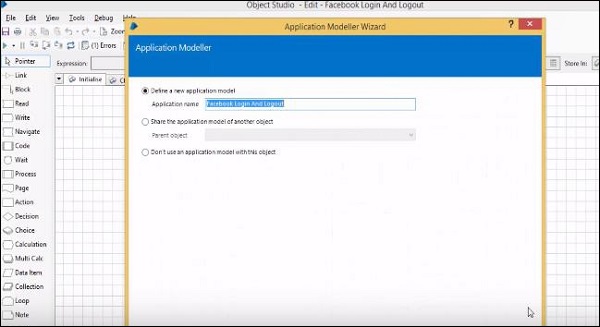
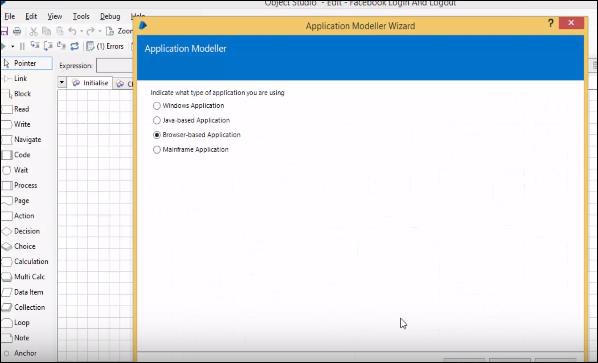
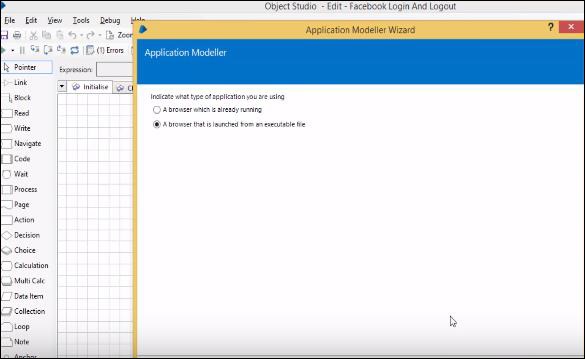
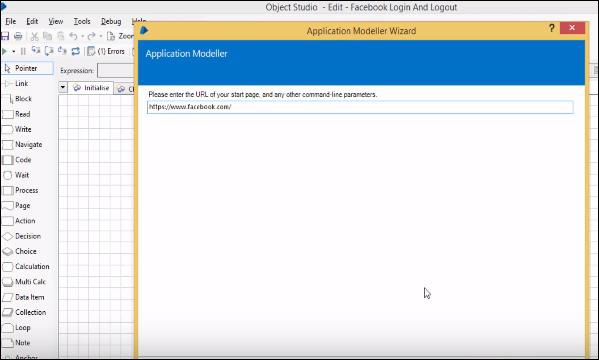
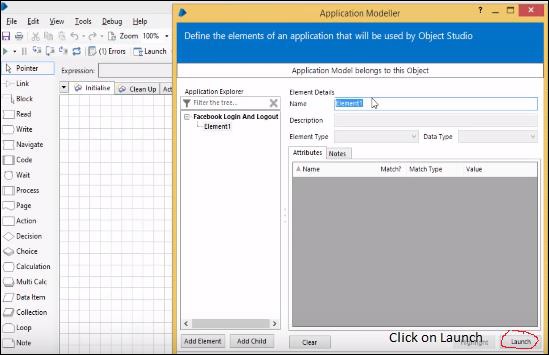
Now we are going to spy the login button, username and password fields.
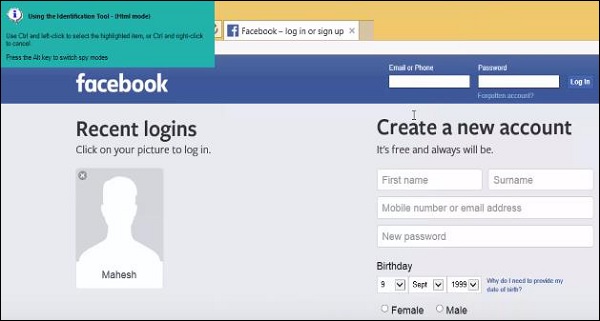
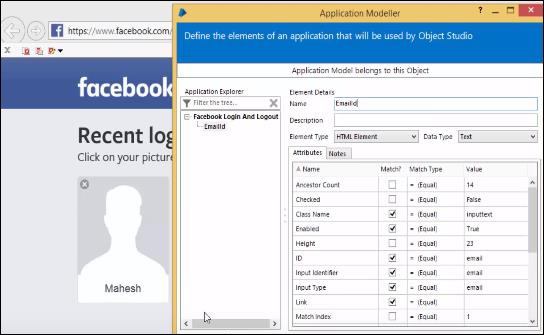
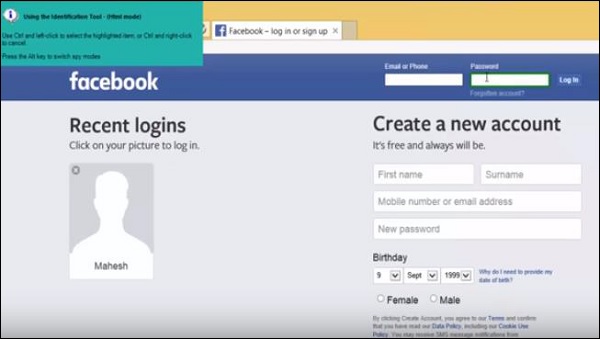
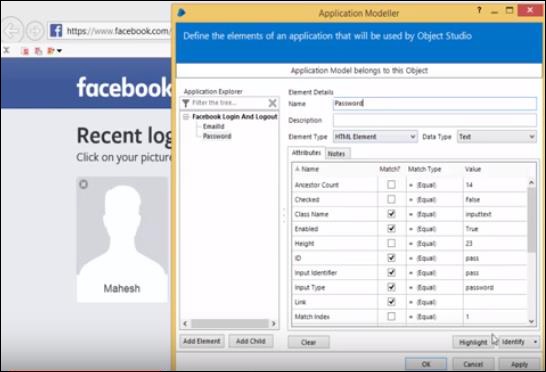
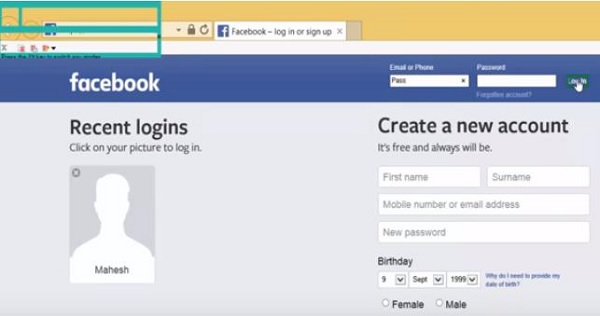
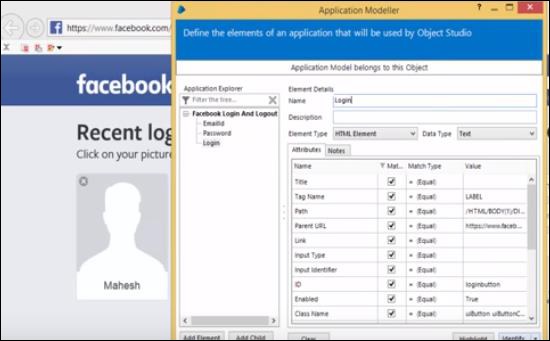
Now, we shall start the implementation part.
Create data items for email and passwords.
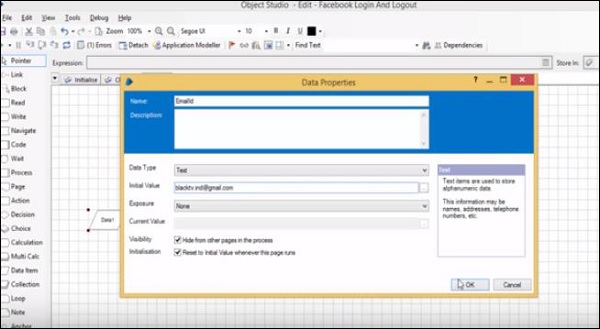
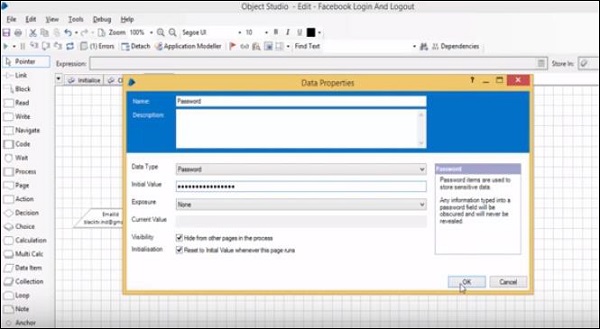
-
Utilize 'write stage' to type electronic mail id and countersign into Facebook site.
-
Click on Login button using Navigate Stage.
-
Nosotros are not getting the Click Actions in Navigate Stage.
-
So, go to Application Modeller and alter the Login Chemical element type to push.
-
Hither, we are using the wait phase to load the site earlier launching the website.
-
At present login to Facebook site.
-
To logout from account, we need to prepare the element in Application Modeller.
-
Spy the required elements, first check what are the elements required for logout.
-
Then, we need to spy the arrow and sign-out option.
-
Utilize Navigate stage to click on arrow and click on logout.
-
Afterward login button the site volition take some time to load Account information. It depends on our network mean internet speed.
-
After login apply conditional expect to hold the assuming until the logout arrow will exists.
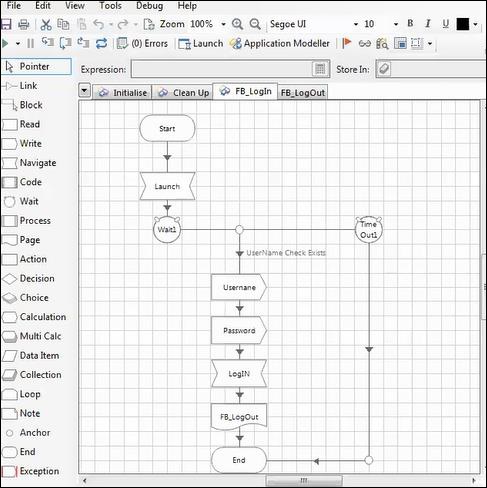
Working with Windows Applications and Multiple Windows
We shall larn how to automate the training club system with the stride-wise process given below. The screenshots given in the subsequent sections assist you understand the process clearly.
Step one − Create the business object.
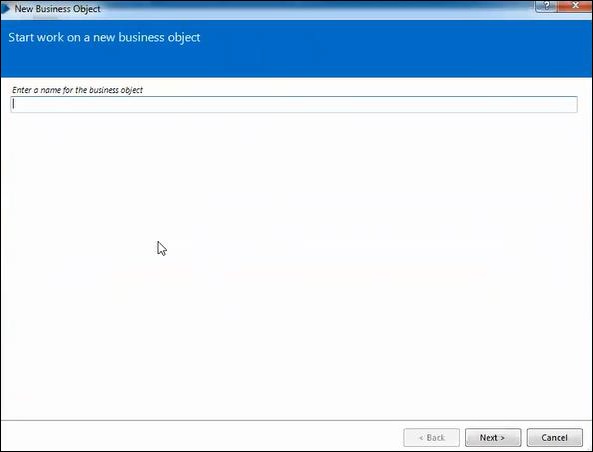
Pace 2 − Configure the Application modeller.
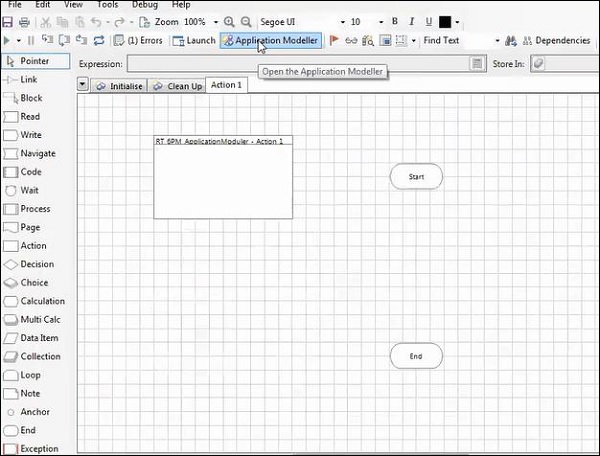
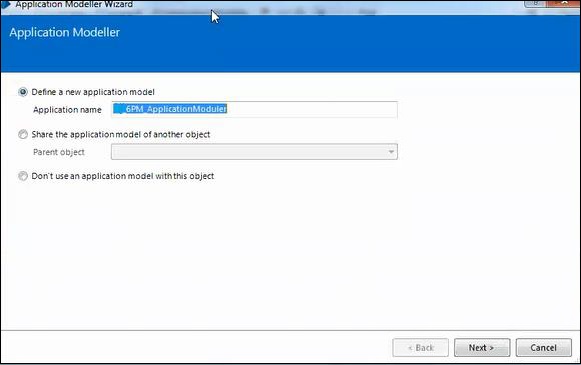
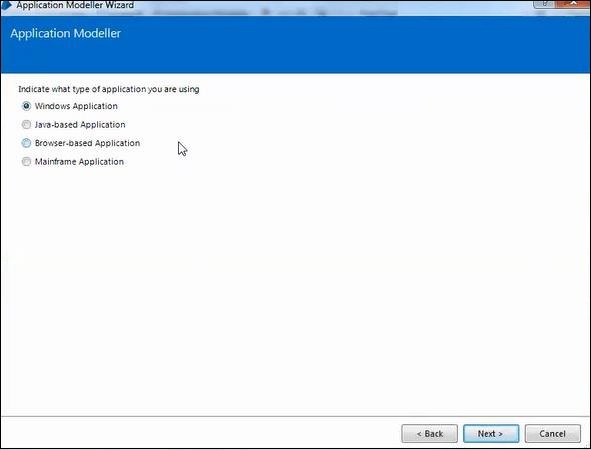
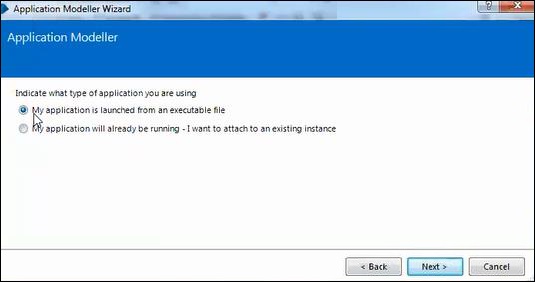
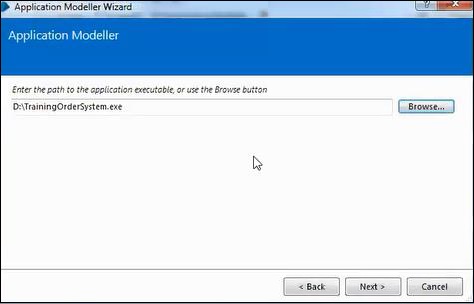
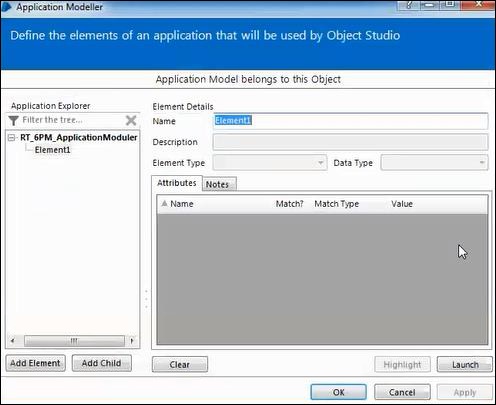

Step 3 − Spying the Sign in window.
Use Ctrl+Left to highlight the element, and ordinal chemical element is used to Unique Identification.
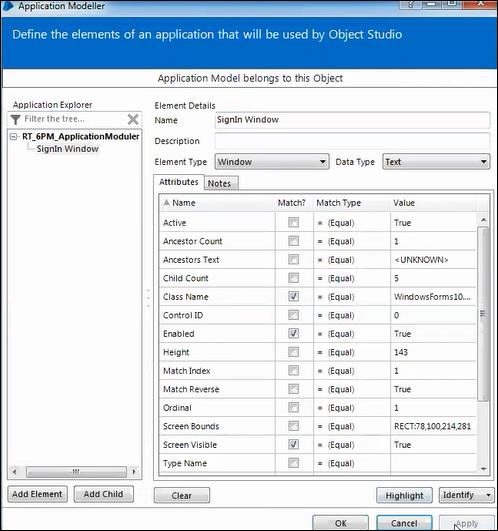
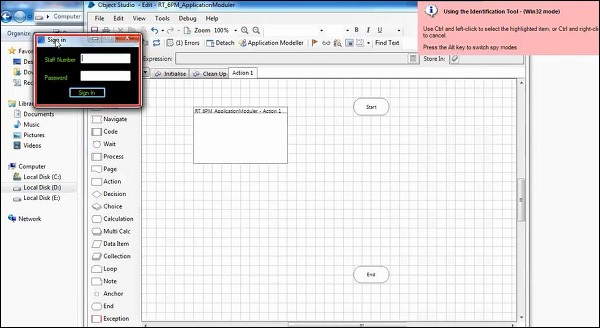
Stride four − Spying the staff number.
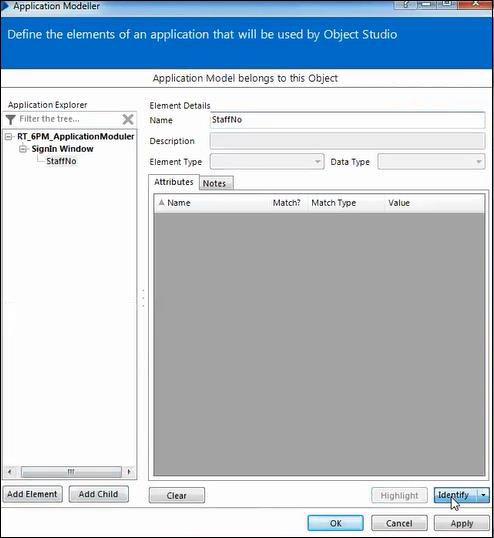
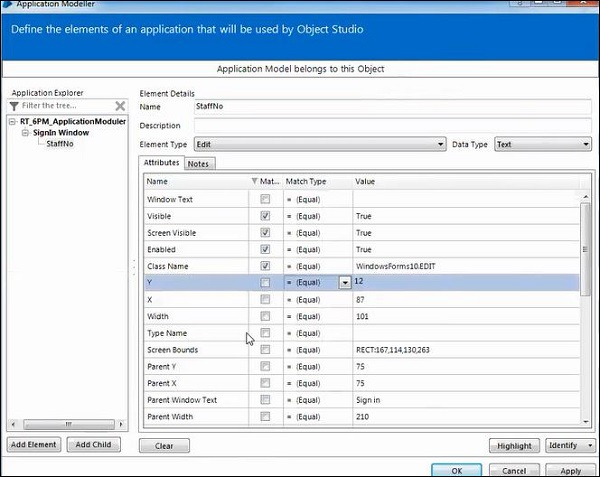
Step 5 − Spying the password.
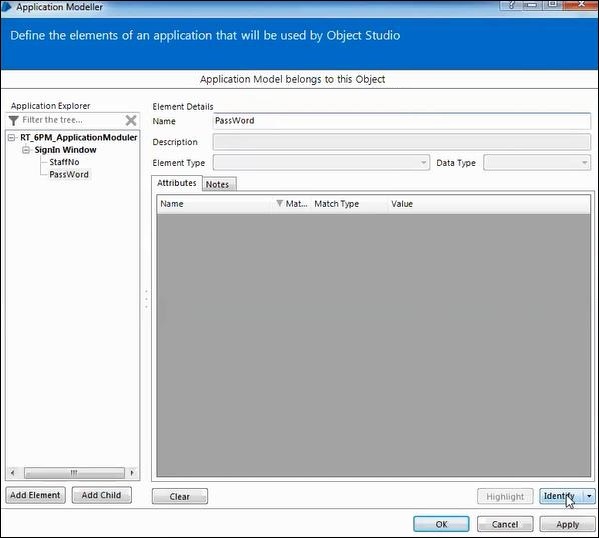
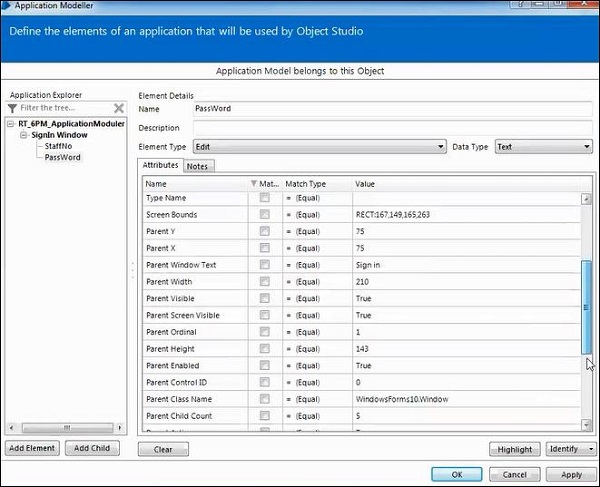
Step vi − Spying the sign in button.
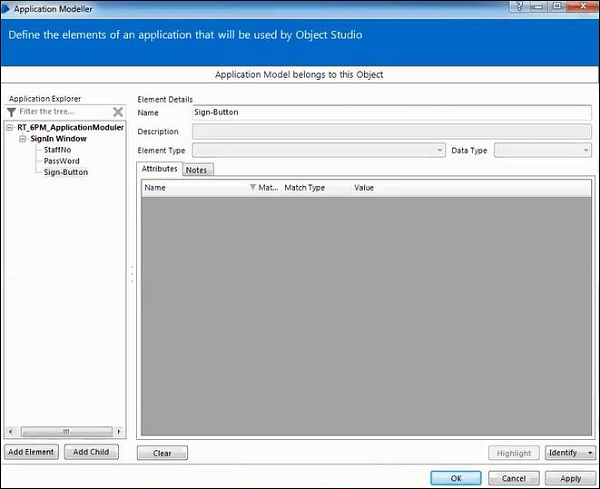
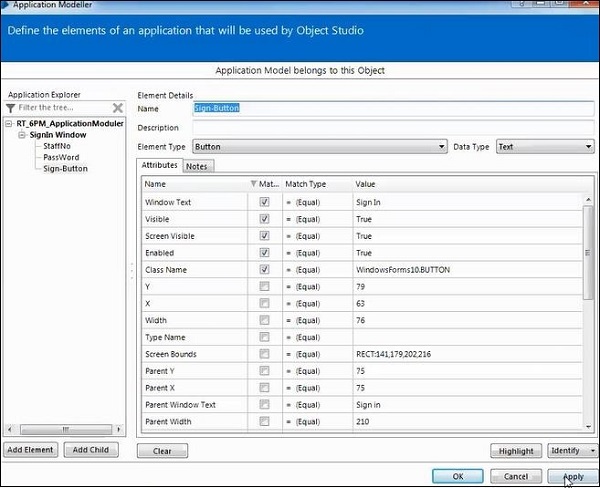
Now we first the implementation part.
Step 7 − Using the Navigation stage to launch the application.
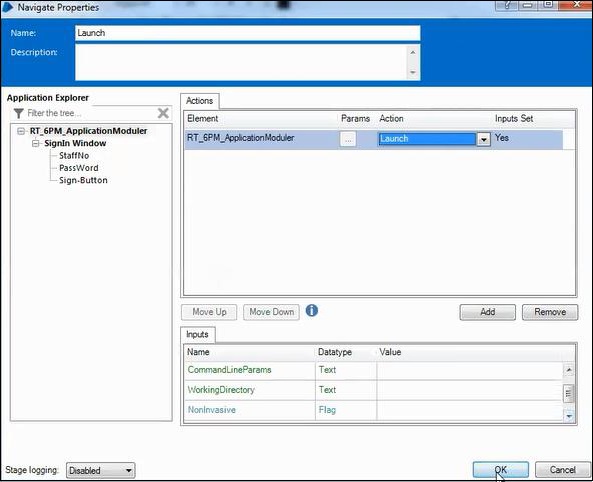
Step 8 − Using write phase to configure the staff number.
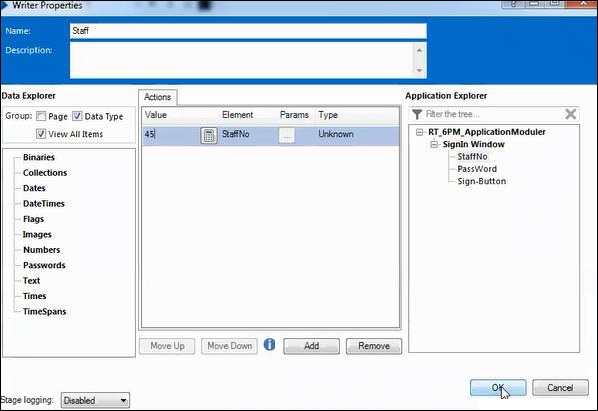
Step 9 − Using another write stage to configure the Password.
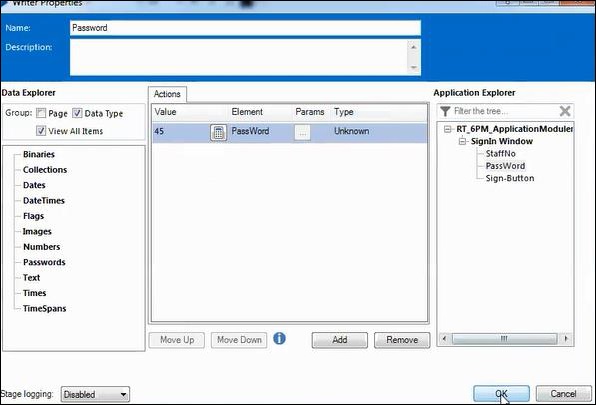
Step 10 − Using Navigate stage to Sign IN.
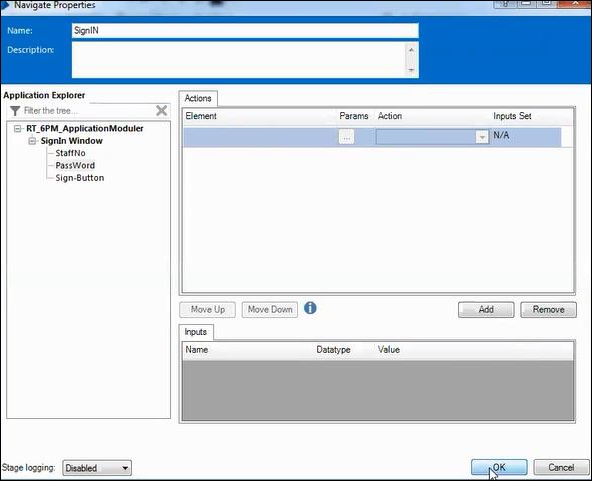
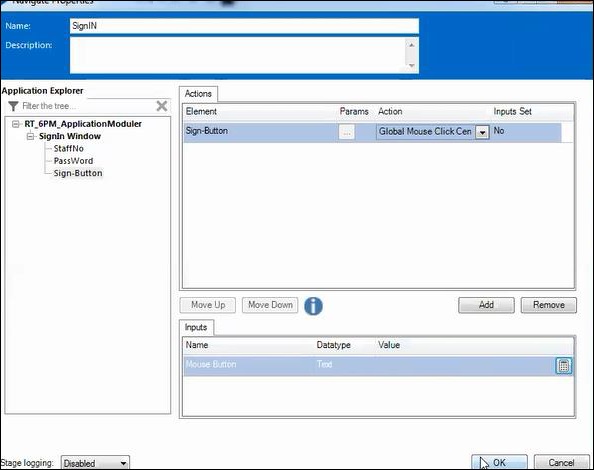
Stride eleven − Link the process.
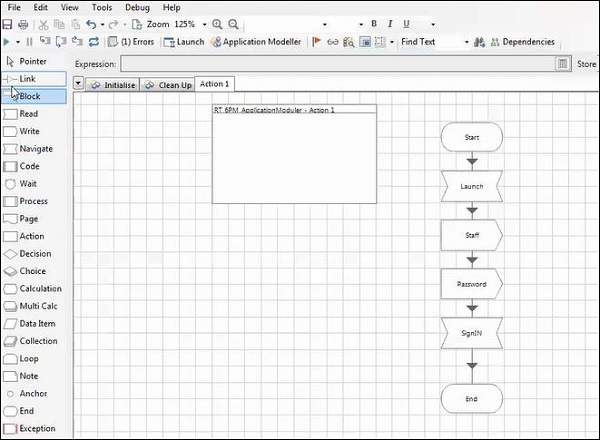
Blue Prism - Procedure Studio
Procedure studio has only Primary page. If the page is published, we can call from the process studio. Nosotros use the Process studio for developing and testing.
Difference between Process and Object Studio
Major difference between process and object studio are given below −
| Procedure Studio | Object Studio |
|---|---|
| It is created as diagram that looks similar flow diagram by development tool | Create Objects graphically by evolution tool |
| Stages: We have Alert stage in Process Studio | Stages: Read, Write, Navigate, Lawmaking and Wait |
| We accept the Primary Page | Nosotros take initialize and clean up Folio |
| Process interacts with object studio and control room | Object Studio interacts with external Application. |
| Launch and Application Modeller is not available | Launch and Application Modeller is available |
Stages in Process Studio
Various stages in the Procedure Studio are given below −
- Link
- Block
- Process
- Page
- Activity
- Decision
- Choice
- Calculation
- Multi Calculation
- Data Item
- Collection
- Loop
- Note
- Anchor
- End
- Alert
- Exception
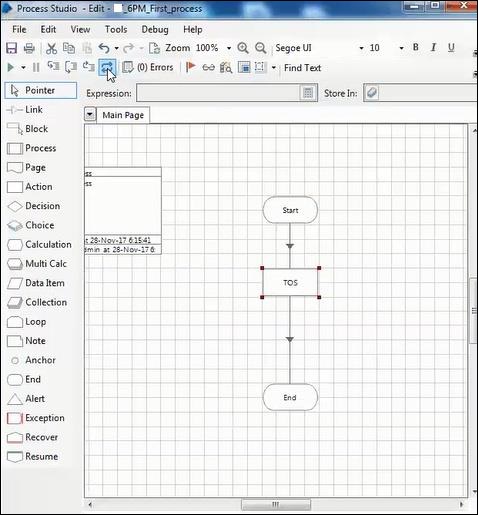
Publishing the object studio pages
We tin can publish the object studio pages using the below steps −
-
Develop the Business organization Object.
-
Deploy the Business organisation object deportment.
-
Publish the object studio.
-
Later on publishing the process, we can run from the Process Studio.
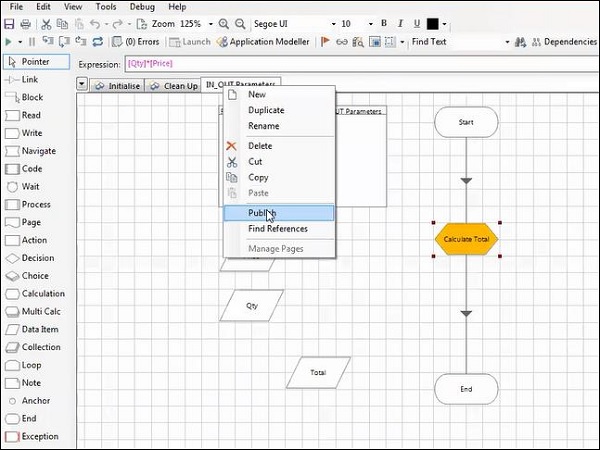
Publishing the Procedure to Control Room
Nosotros can publish the process to control room using below steps −
-
Develop the process object.
-
Double click on the description.
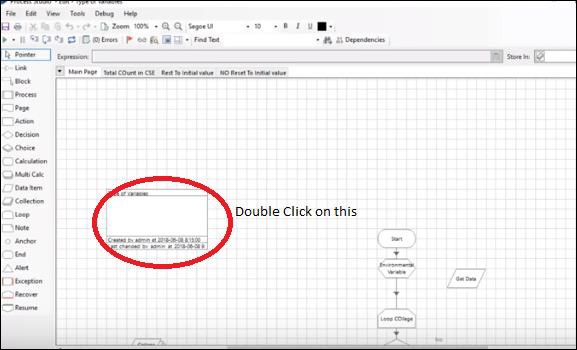
Then select the check box publish the process to command room.
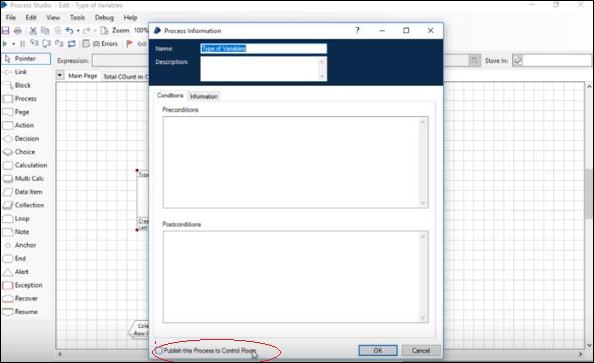
The published process displayed in the available process.
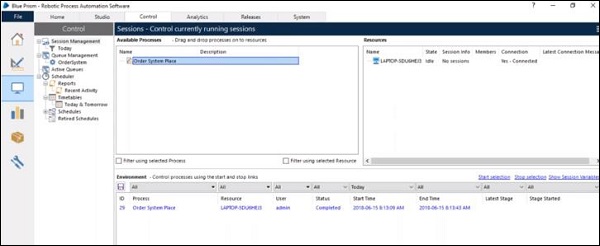
Input/Output Parameters Passing
We want to laissez passer some parameters to ane page to another page using the input/output parameters.
-
We create the input and output parameters in process studio.
-
We need to declare the input parameters at the start stage.
-
We need to declare the output parameters at the end phase.
We shall await at a pace-wise approach to pass Input and Output parameters −
Step 1 − Create the business object.
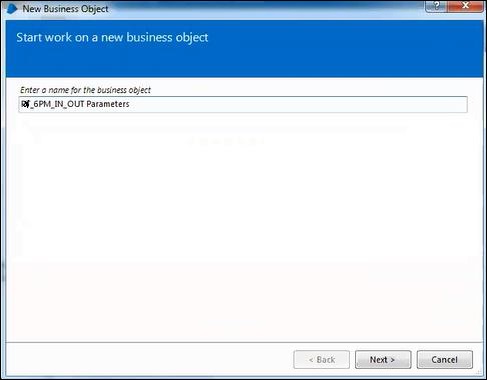
Step two − Define the input parameters in Commencement stage.
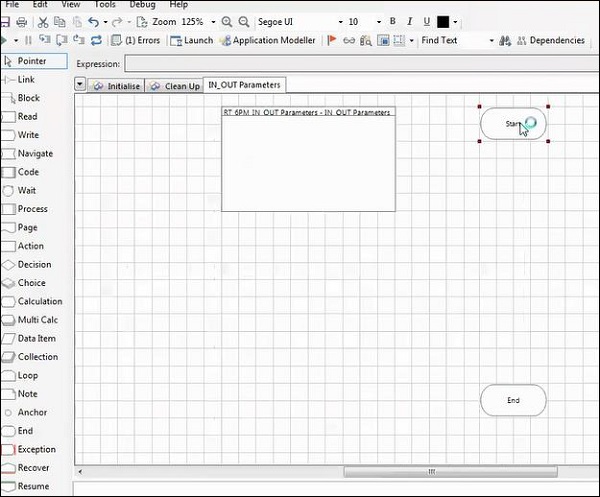
Step 3 − Double click on Starting time Phase to configure the input parameters.
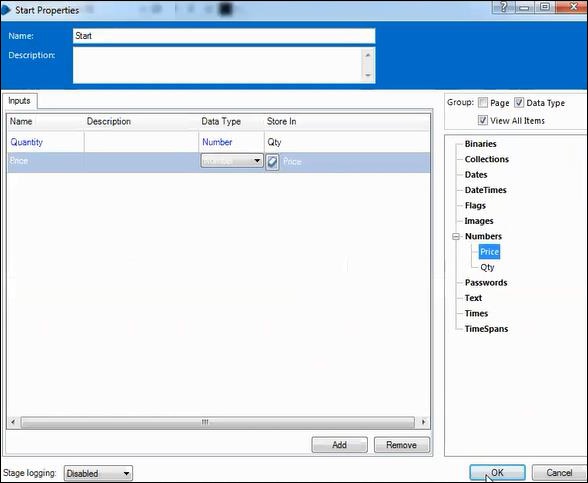
Step 4 − Ascertain the output parameters in End Stage.
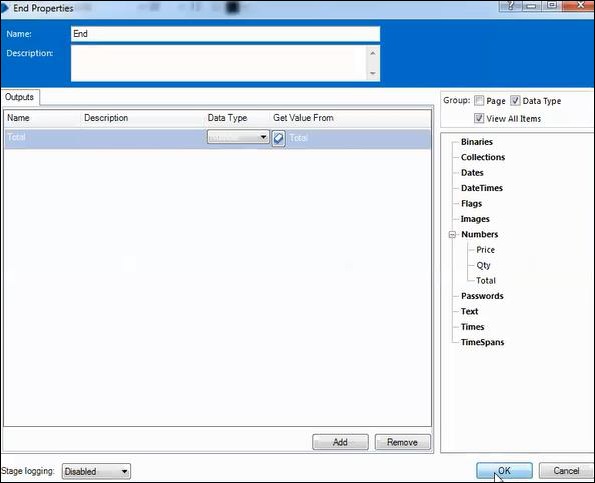
Step v − Get to adding Stage for unproblematic calculation.
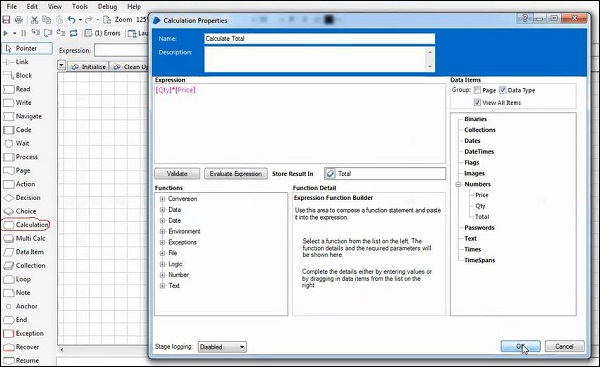
Step 6 − Connect the process and save it.
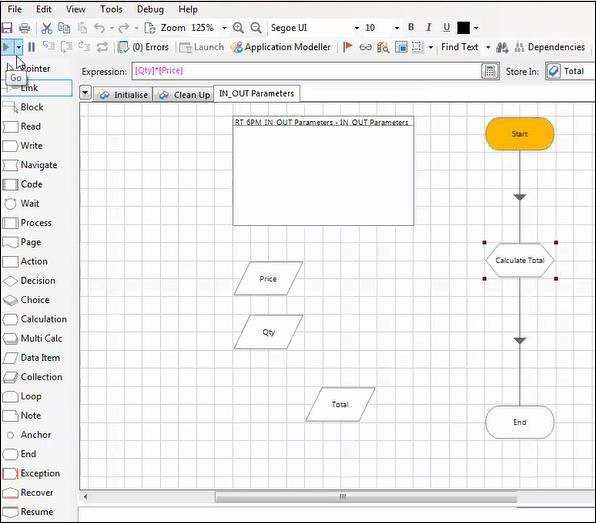
Step 7 − We must publish the process.
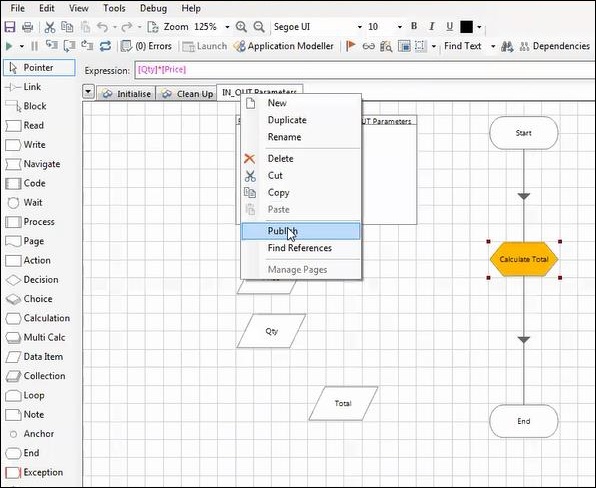
Footstep 8 − Afterward publishing the process, we tin can run from the Process Studio.
Pace nine − We need to create the process in process studio.
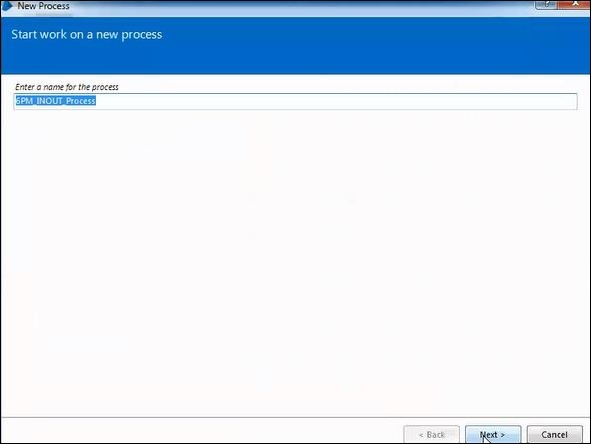
Step 10 − Apply the Action phase to call the procedure from object studio.
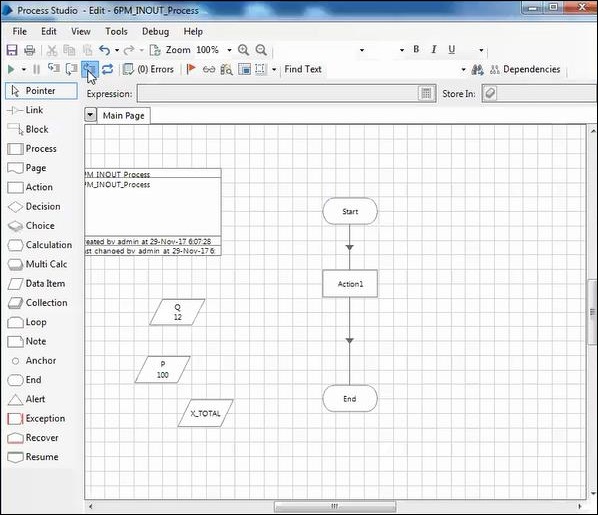
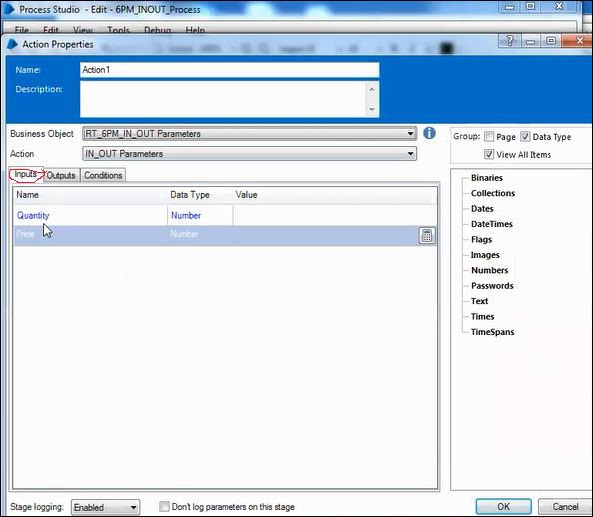
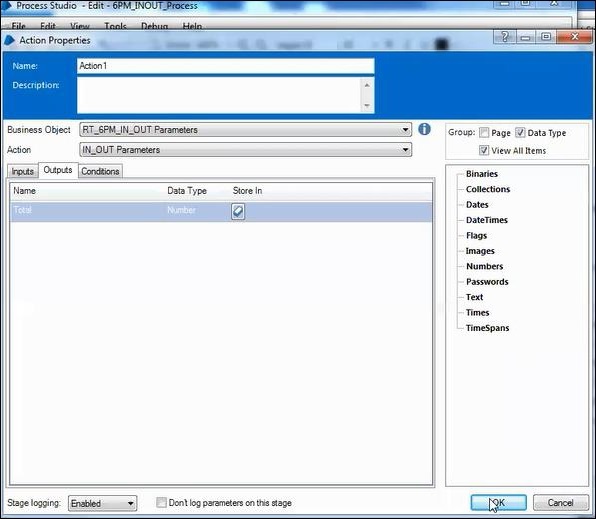
Step xi: Create the data items and run the process.
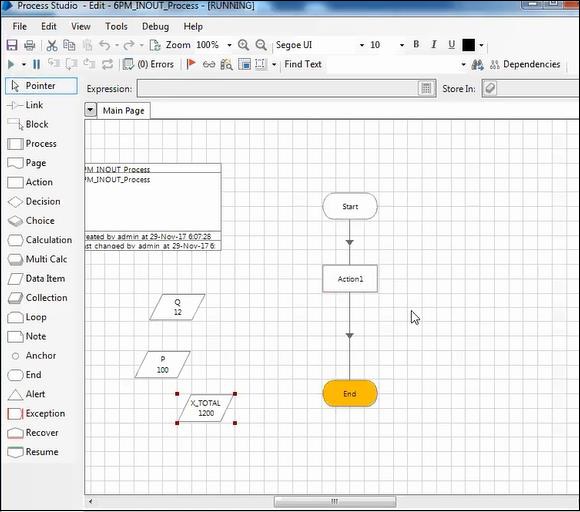
Blue Prism - Exceptions Handling
Exception handling is defined by the management of exceptions in unassisted automation. It ensures that problems tin be automatically resolved if possible, or hands identifiable and repairable by system administrators or passed for human completion where appropriate. The success of exception handling depends on how well it is implemented during evolution.
Achieving Exception handling in Blueish Prism
Exception handling is a critical part of whatever blue prism solution. An exception is a problem that arises during the execution of a process/object.
When errors are encountered in bluish prism, it generates exceptions.
Exception Handling Stages
Exception handling can exist achieved past using resume, recover and exception phase.

Recovery − Begins a block for treatment exceptions.
Resume − Ends a block for treatment exceptions.
Exception − Explicitly raises an exception in the execution of process or object.
Types of Exceptions
We have 3 types of exceptions in Blueish Prism −
-
Internal Exceptions
-
System Exceptions
-
Business Exceptions
Internal Exceptions
Internal Exceptions come based on our missing mandatory data in stages.
Suppose, nosotros want to save the data for newly created excel. However, we missed to provide path, and so nosotros go the internal exceptions.
Another example is when we give invalid expression in calculation stage, we get internal exceptions as shown below −
-
Create 3 data items i.e 10, Y and Z with text type.
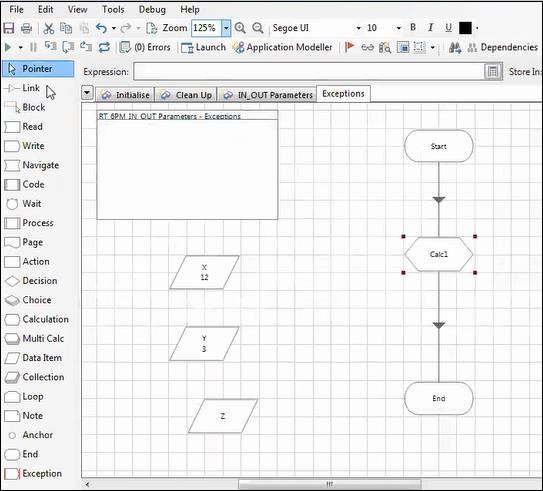
-
Use calculation stage to perform the simple calculation
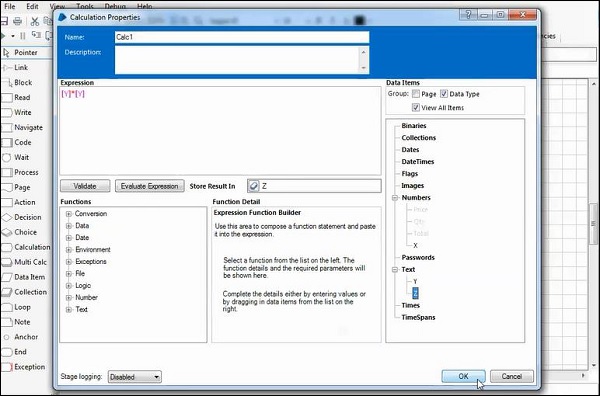
-
Now, run the process.
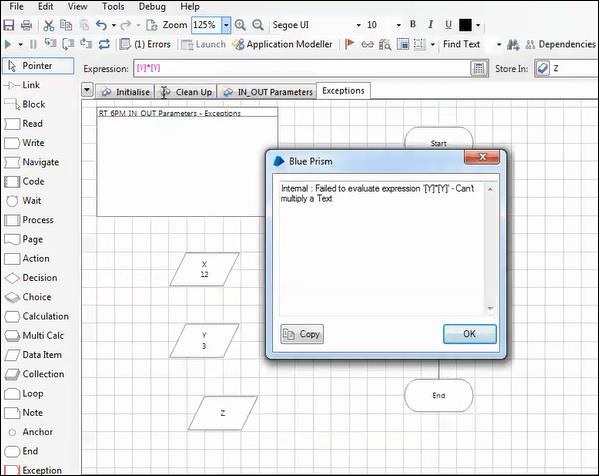
Business Exceptions
These exceptions are non really exceptions, however, based on the business rules, we are creating the exceptions. We need to burn manually through bot.
Allow us suppose, we working on excel information having the employee name and his account residue. Reading these information into collections and checking the balance of each employee. If the balance of whatsoever employee is cypher, we need to fire exception and log the message. As per concern rules, if the balance is naught, the payments cannot be done.
Step i − First, we will read the information and store the collection.
Stride ii − Nosotros need to loop collections and check if the cavalcade has null. If aye, then throw an exception.
Step 3 − We need to configure the Exception stage. As we have and so many exceptions types, we need to configure this as Business concern Exception.
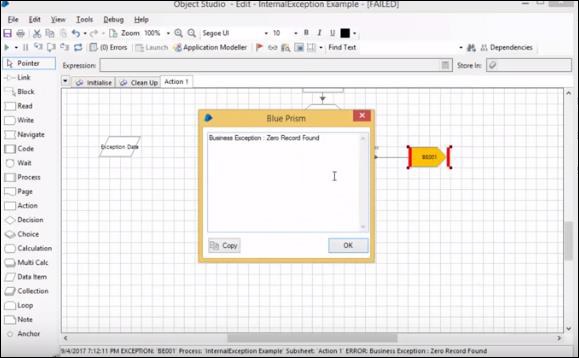
System Exceptions
System Exceptions will occur based on internet is downwards or our bot need internet or any organization failures.
Nosotros need to handle these Exceptions using the Recovery and Resume stages. We don't need to link to recovery stage, whenever and whereever exceptions fires, immediately the recovery phase catches those exceptions.
Exception Bubbling
When the Exception is fired, information technology moves upwards towards the flow until it gets defenseless by recovery is chosen Exception blubbing.
Blue Prism - Work Queues
A work queue is an internal configurable list that enables a Procedure to manage its workload. A process can apply different work queues and a work queue can be shared by multiple processes if required.
The Queue Management tab in Command Room provides the operational user interface for work queues. The tab is divided into ii: a listing of queues is shown in the upper half, and the lower half shows a list of the items in a queue.
Work Queue Configuration
Piece of work queues are created in Organization Manager, the authoritative are of Blueish Prism.
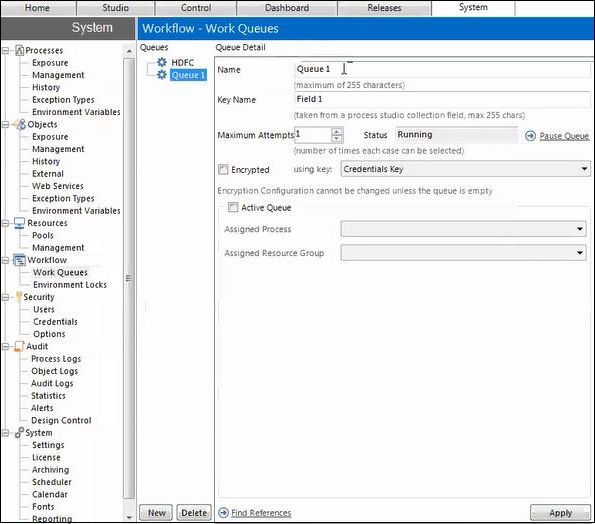
Tags
A Tag is a keyword of term assigned to a Work Queue item as a method of categorizing or grouping that item.
Calculation tags
Adding a Tag to a Work Queue item simply requires the employ of an Action Stage. Add an Action phase into your procedure menstruum. In the Activeness phase, perform the post-obit actions −
-
Select the Internal – Piece of work Queues Concern Object.
-
Select the Tag Item Action.
-
Set the Item ID Input Parameter to be the Item ID for the Work Queue Item you wish to tag. The item does not demand to be locked to add a tag.
-
Set the Tag Input Parameter to exist the Tag that you want to add to the Work Queue particular.
-
Click OK.
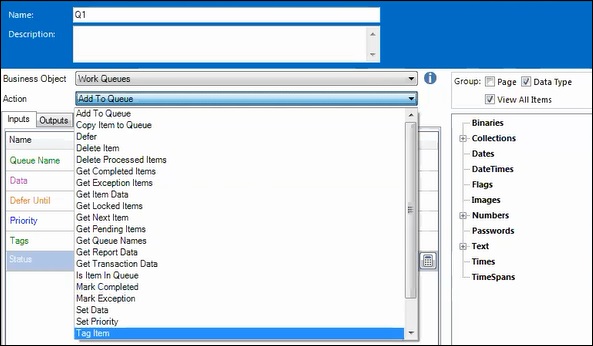
Removing Tags
Removing a Tag from a Work Queue item also requires the use of an Activity stage. To remove a Tag, follow the below steps in Process Studio −
-
Add an Action phase into your process flow.
-
In the Activity Properties, perform the post-obit −
-
Select the Internal – Piece of work Queues Business Object.
-
Select the Untag Item action.
-
Set the Item ID Input Parameter to be the Item ID for the Piece of work Queue Item you wish to un-tag. The particular does not need to be locked to remove a Tag.
-
Fix the Tag Input Parameter to be the Tag that you desire to remove from the Work Queue item.
-
Click OK.
The following screenshot explains the above steps conspicuously −
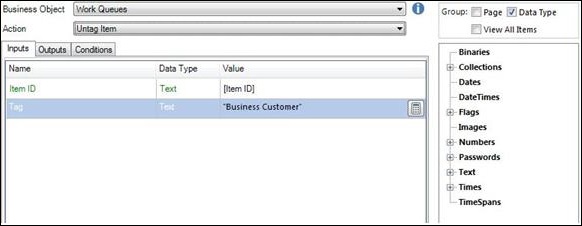
Condition
Each Work Queue item has a status. The status tin can be used as a method of recording what work has been done so far on a Work Queue particular
Setting the Status for a Piece of work Queue item simply requires the utilise of an Action phase. The following steps will be required −
-
Add together an Activity stage into your process flow
-
In the Activeness Properties do the following −
-
Select the Internal – Piece of work Queues Business Object.
-
Select the Update Status action.
-
Set the Detail ID Input Parameter to exist the Detail ID for the Work Queue Detail you wish to assign a status to.
-
Set up the Status Input Parameter to exist the Condition that y'all want to update the Work Queue particular with.
-
Click OK
The following screenshot explains the above steps clearly −

Using Status
Your process can likewise be configured to use the item status to ensure steps within your procedure that should never be repeated.
To utilise the Particular Status, simply add determination stages to your process that checks the Particular Condition and so that whatever parts of your process that have already been done for the item tin be skipped. Retrieve, the Particular Status can be returned every bit an output from the Go Next Item activeness.
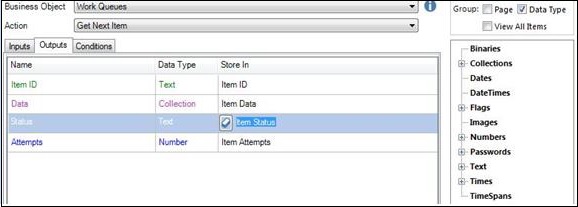
Priority
When designing an automated solution, y'all should consider if any different work types or scenarios inside the procedure should exist worked before the other worked items.
Using Priority
The Priority for a Work Queue particular is done when the item is showtime added to the queue using the Add together To Queue action. The Priority of an detail cannot be inverse after information technology has been added to the queue.
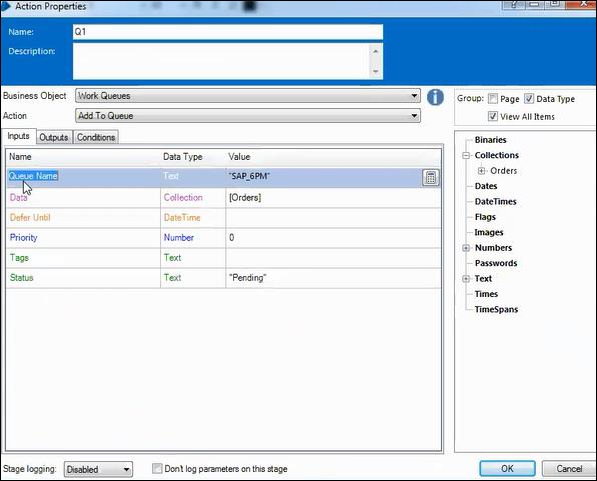
Active Queues
Using the traditional session direction model, sessions are started on resources which poll the work queue for cases to work. These sessions are started in Control Room manually, or via a scheduler service which is running on a Blueish Prism Server instance.
Agile queues introduce an alternative mechanism for managing the sessions which work the queues, made possible by creating a closer clan between work queues and sessions.
Instead of creating sessions separately in Control Room and so moving to the queue management page to see the results, active queues let you to set a target number of resources which should be working the queue. Blue Prism uses the active queue configuration to decide how to achieve that target.
Active Piece of work Queues are but useful when running dozens of sessions for one process. When this is not the case, the benefits of Active Piece of work Queues will not be realized.
Blue Prism - Credentials Managing director
Credentials are a secure repository for details used to log in to target applications. They are encrypted in the Blue Prism database to make them only accessible to those who should be able to use them.
The Credentials Management arrangement determines which Processes, Resources and Roles accept permission to access the information, and a special Internal – Credentials Business Object provides actions for using credentials.
To configure the credentials, Go to Organization Managing director → Security → Credentials.
Before creating the credentials first, we demand to configure the cardinal, so only it will let to create credentials.
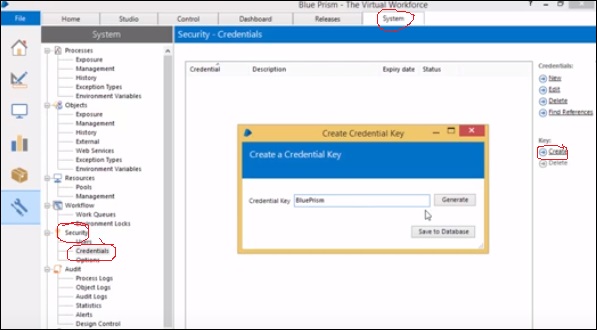
Creating the credentials.
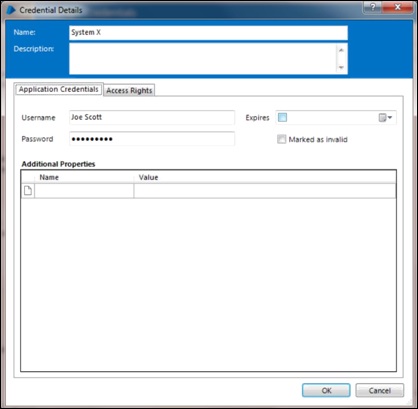
User, Role and Log Management
In this chapter, we shall discuss well-nigh User, Role and Log Management in Blue Prism Environment.
Stride 1
Login into blueish prism
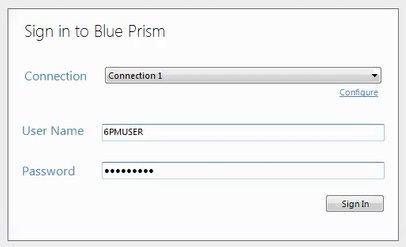
Step 2
Select system → Security →User
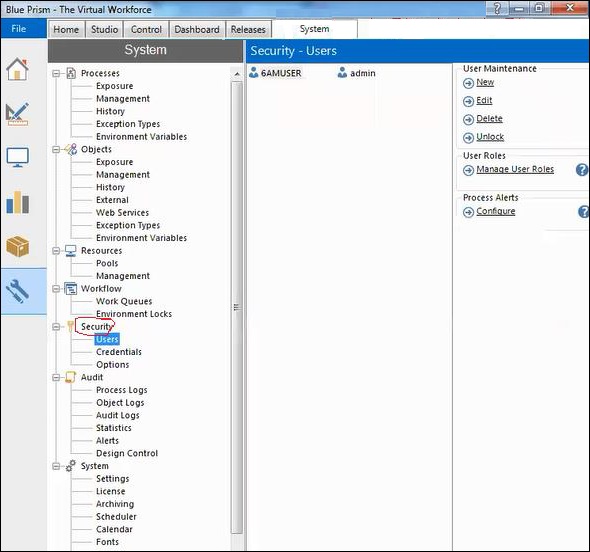
Step iii
Window volition open up right side we tin can observe the new choice click on it.
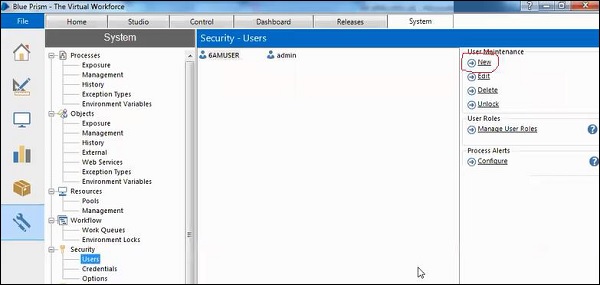
Footstep 4
Window will open with proper name every bit create user sorcerer their enter proper name and countersign.
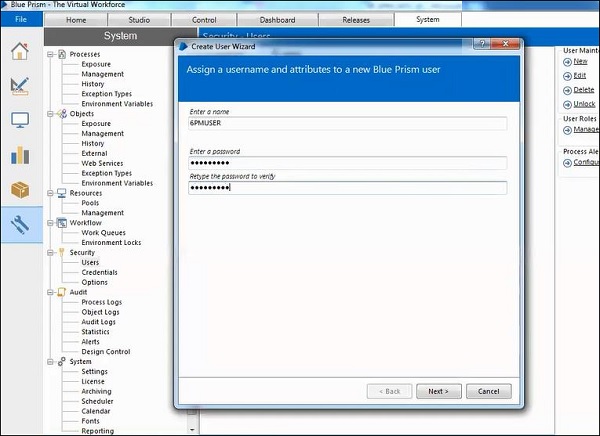
Step 5
Click next button and a window will open give the password duration and assign the role.
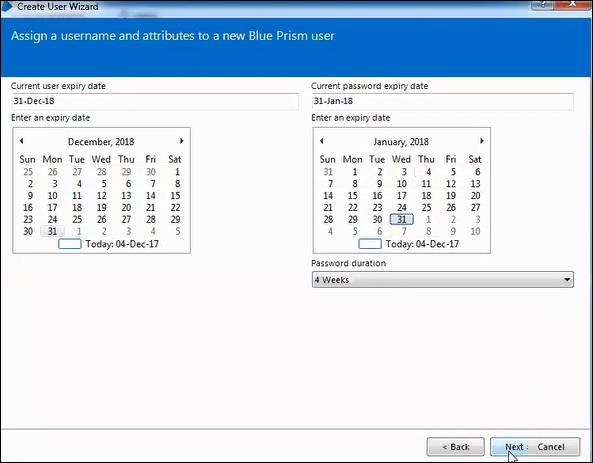
Step 6
Nosotros gave permission to access evolution then click finish.
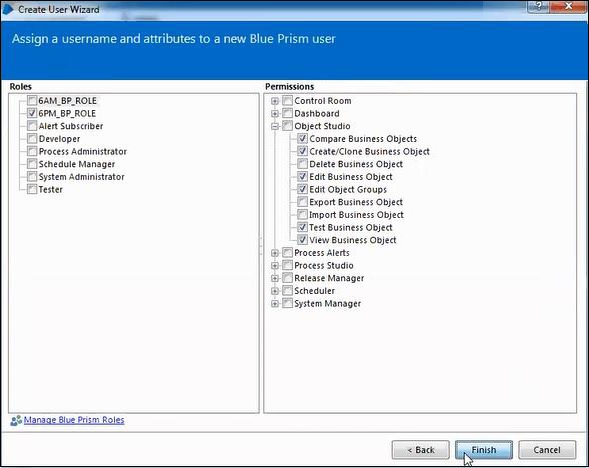
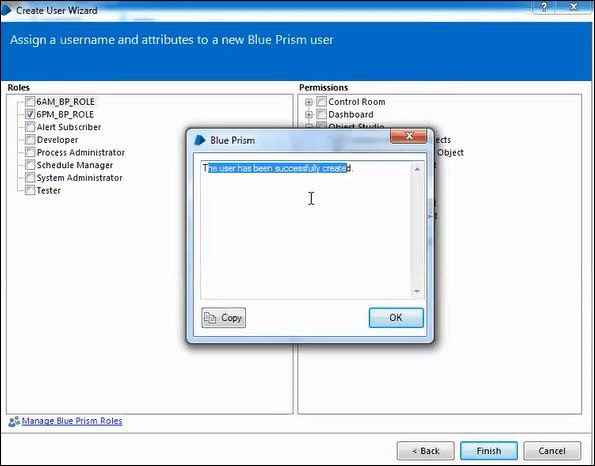
Now logout form the admin user and then login with user which we created.
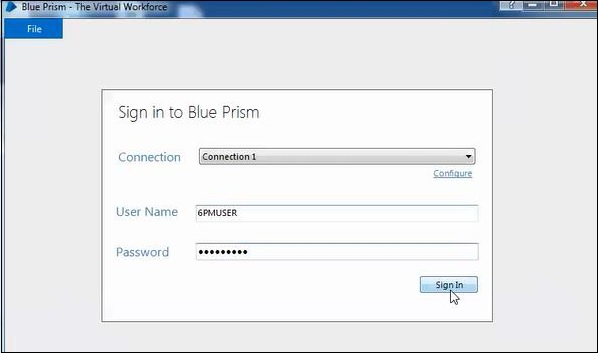
Nosotros can find that access home and studio because gave permission to access the evolution only.
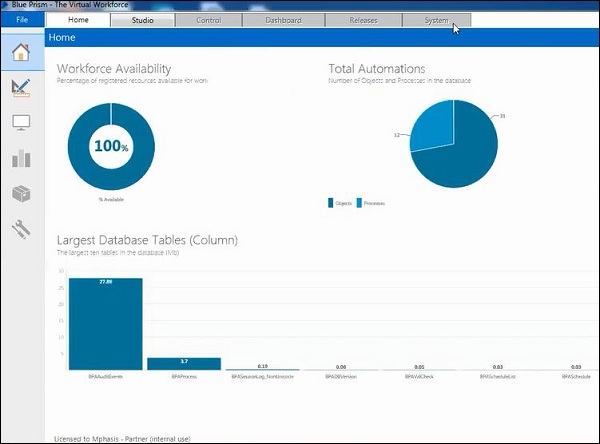
E-mail and Surface Automation
We shall discuss e-mail automation and surface automation topics in this chapter.
Electronic mail Automation
Before performing email automation, nosotros need to give permission to our Gmail business relationship we are currently using.
Follow the beneath steps to give the permission to the Gmail account −
Go to My Account page → Click on Sign-in & Security → Scroll to stop of the page and select less Secure apps option → Enable information technology.
Step one − We need to configure the email settings in action.
Footstep two − Create ii data items for username, password, from email address and to email accost.
Step three − Provide the POP3 and SMTP server details
Stride 4 − Provide the POP3 and SMTP port Details.
Step five − Provide the true for POP3 UseSSL and SMTP UseSSL. The screenshot given beneath explains all the above steps clearly.
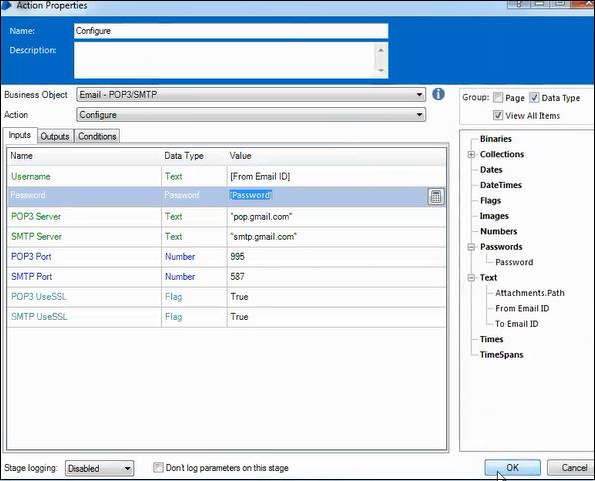
Step 6 − Allow united states of america name it as "Ship post".
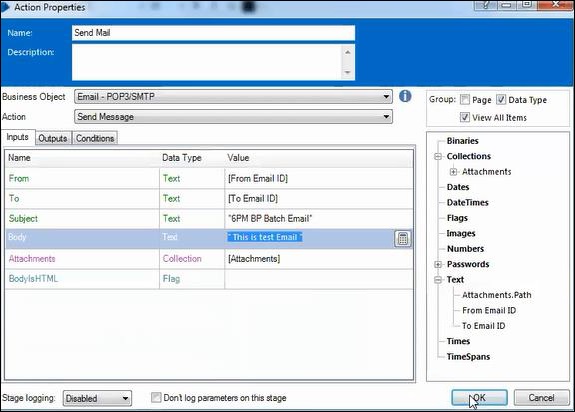
Stride vii − Next step is to link the process.
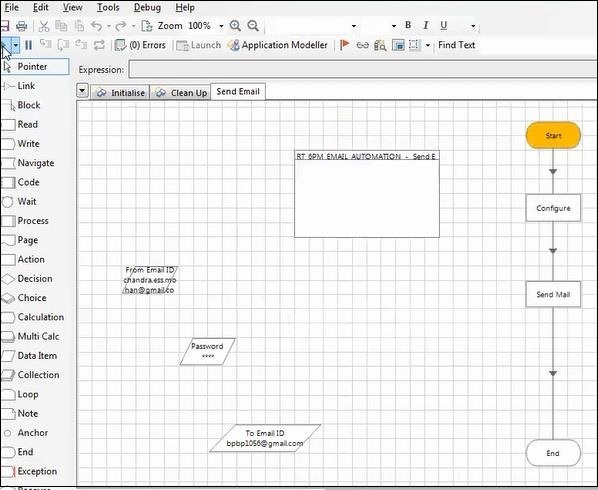
Surface Automation
Blue Prism provides Surface Automation techniques that can exist used as an alternative when technology connectors are not bachelor. Some of these Surface Automation techniques are briefly described in: Regions, Character Matching, Global Clicks, and Keys sections.
Follow the beneath steps to run surface automation in your device. Screenshots are included later each pace for easy understanding −
Step ane − Create the business object and configure the Application modeller with Surface Automation.
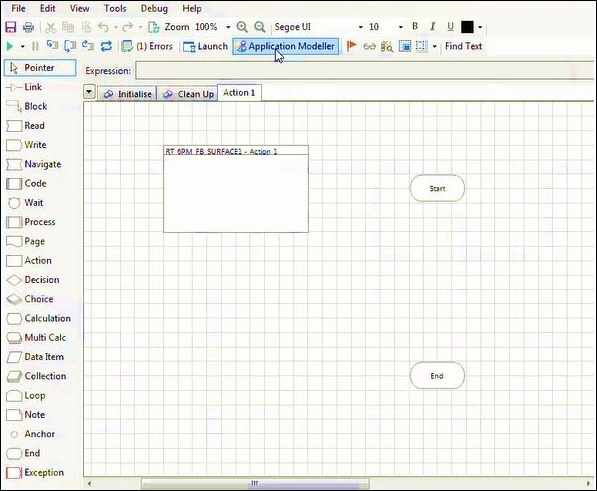
Pace 2 − In the next step, we need to ascertain a new awarding model name as given below −
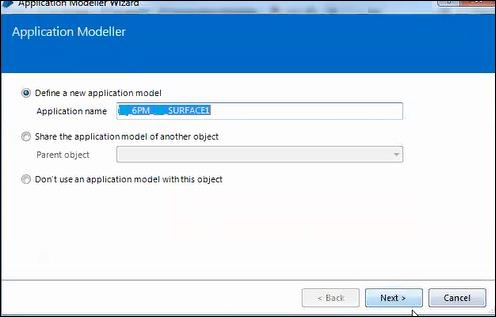
Step iii − Based on the application type in use, select one as shown beneath −
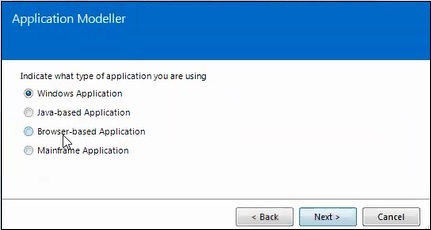
Step 4 − Point the type of awarding being used.
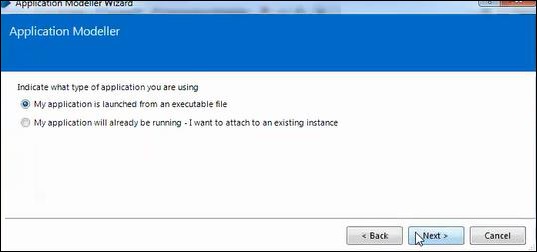
Pace 5 − In this pace, enter the path where the .exe file is saved or browse the location using Browse push every bit shown below −
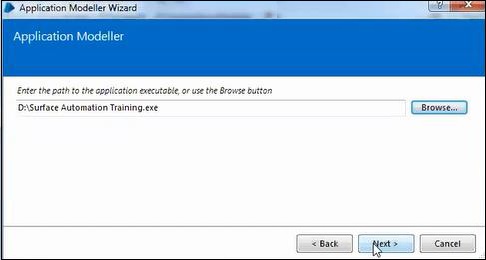
Step half-dozen − Enter the Element details and launch the application.
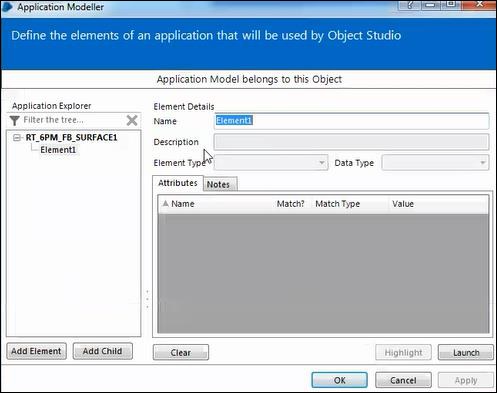
Step 7 − We can launch the application using the launch push at the lesser as given below.
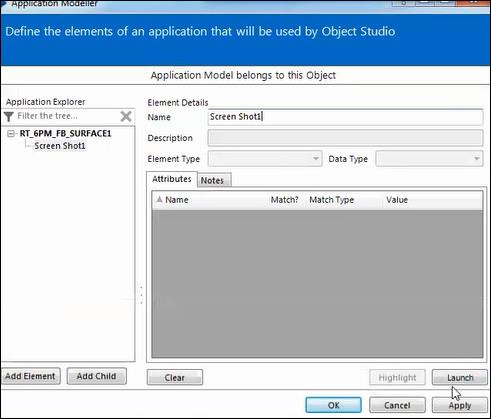
Stride eight − Login into the application using the credentials.
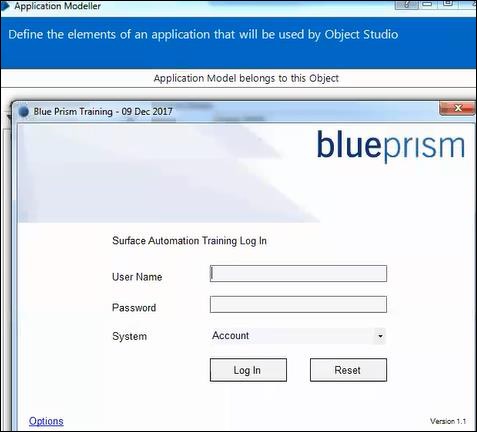
Pace 9 − Place the spy elements as shown beneath −
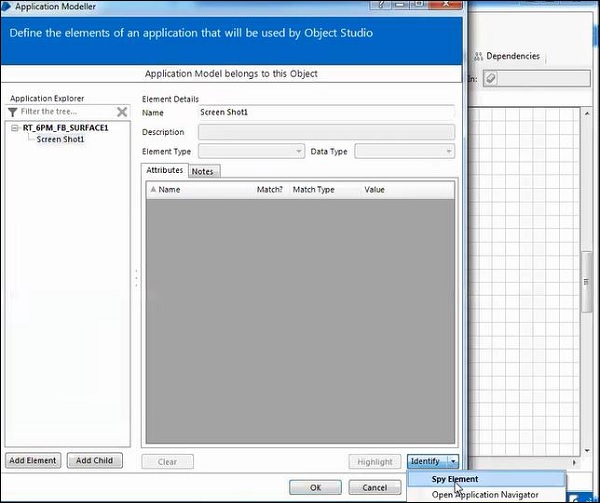
Stride x − In this stride, we need to place the username and password.
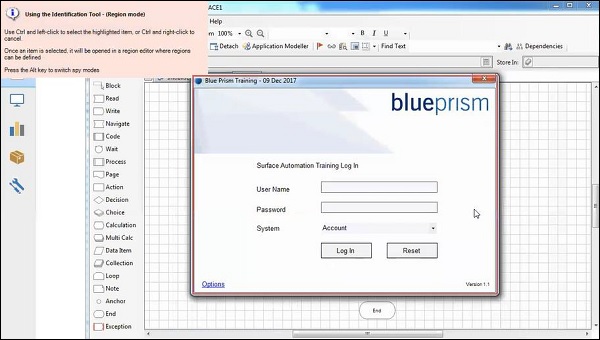
Step 11 − Place the User Name.
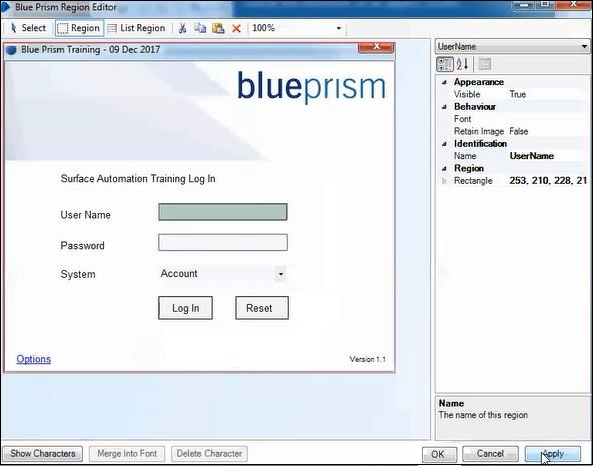
Step 12 − Identify the password.
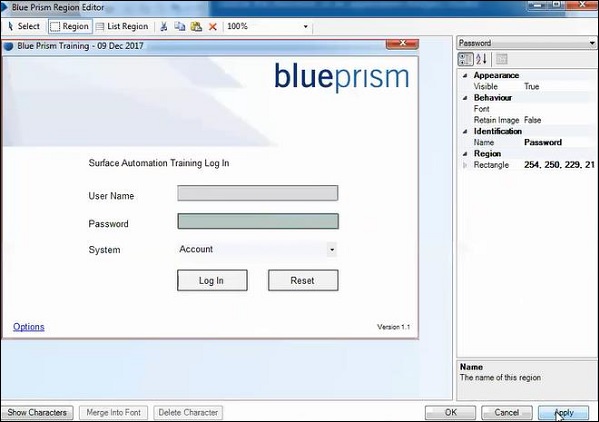
Step xiii − Place the login push.
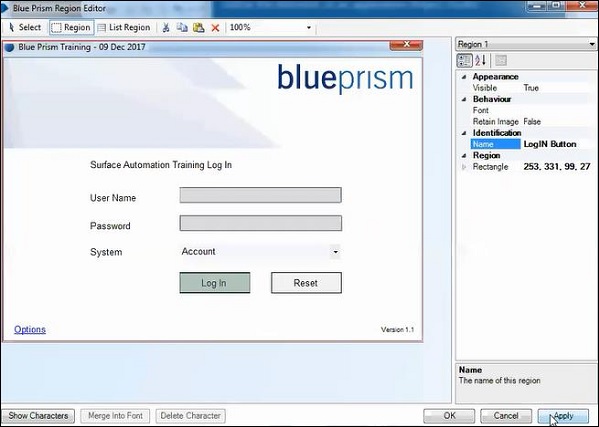
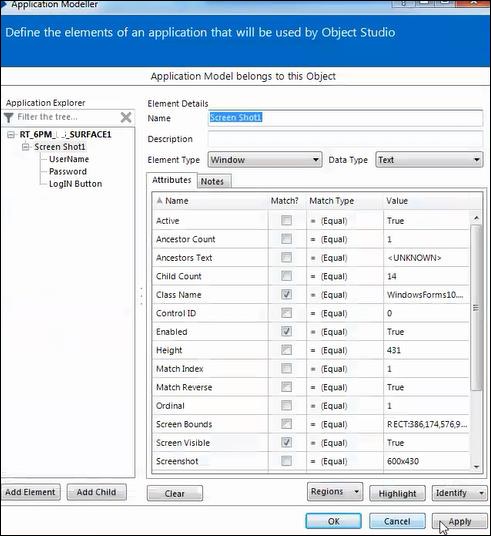
Footstep 14 − Create the two information items: username and password.
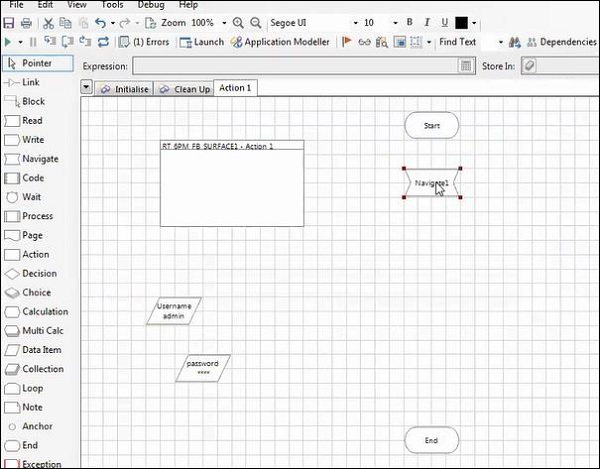
Step xv − Launch the application using the navigation phase.
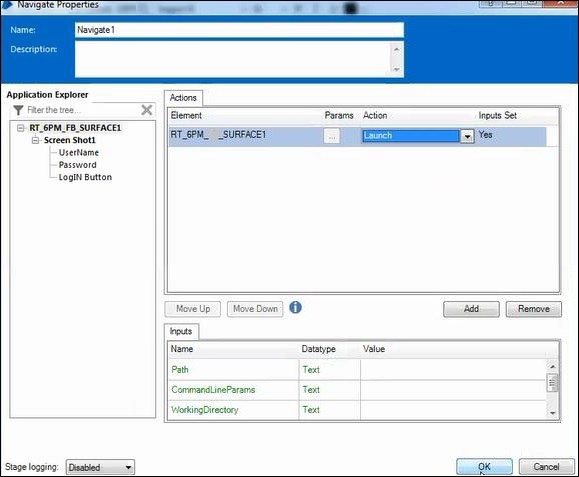
Step 16 − Configure the username using the navigation stage.
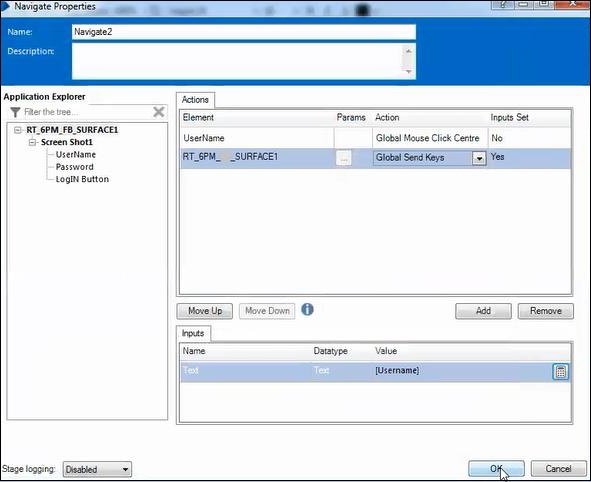
Step 17 − Configure the password using the navigation stage.
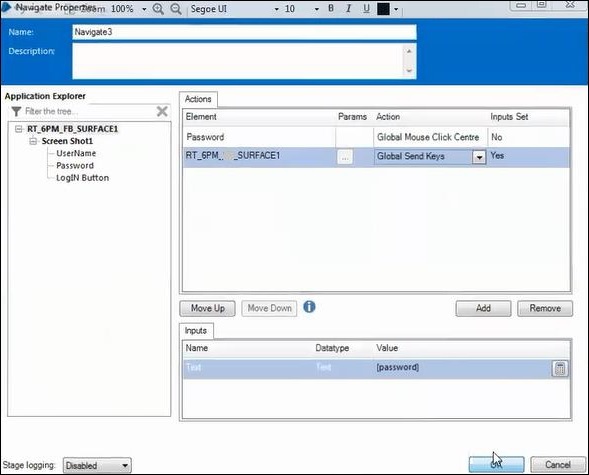
Step 18 − Now, run the process.
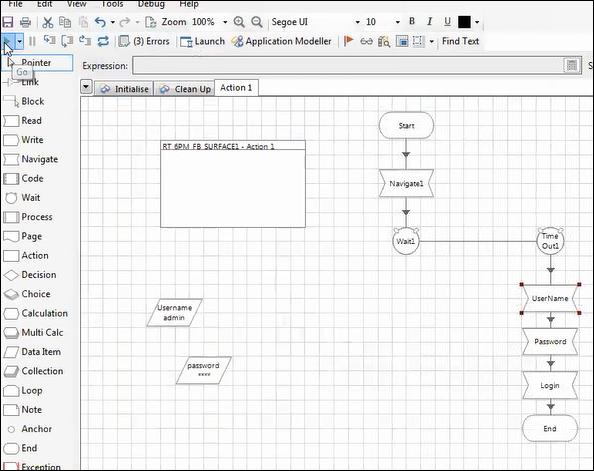
Blue Prism - Schedule Direction
In this section, we shall discuss about schedule management.
Scheduler
Blue Prism tool allows to execute processes at specified times and repeat their execution at various intervals. It is termed as Scheduler.
Configure Scheduler
In the System tab, we have Scheduler pick. Configure the scheduler as shown below −

After we configure the scheduler, we need to click on the Check box to activate the scheduler as shown below −
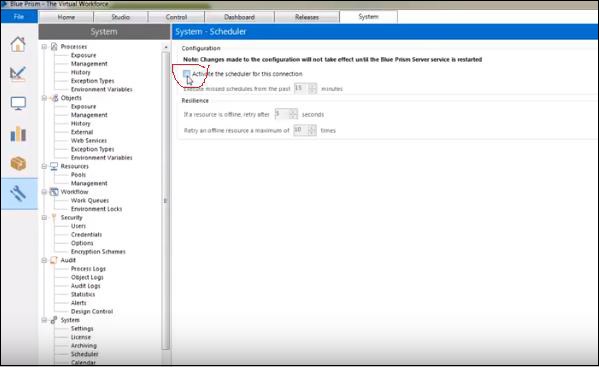
If the resources is offline, nosotros have retry pick under Resilience in the scheduler. Nosotros can choose to retry in the terms of seconds and number of times.
Which Data Type We Use For Mobile Number In Blyerpsim,
Source: https://www.tutorialspoint.com/blue_prism/blue_prism_quick_guide.htm
Posted by: bakerbeforning1959.blogspot.com


0 Response to "Which Data Type We Use For Mobile Number In Blyerpsim"
Post a Comment